17. THE POST-WAR WORLD

THE POST-WAR WEST
The Late 1940s
CONTENTS
 The dividing and occupying of Germany The dividing and occupying of Germany
 The Nuremberg War Crime Trials The Nuremberg War Crime Trials
 Dealing with post-war Japan Dealing with post-war Japan
 Post-war America Post-war America
 Post-war Great Britain Post-war Great Britain
 France's new Fourth Republic France's new Fourth Republic
 Italy rebuilds Italy rebuilds
 Some of the other countries in the new Some of the other countries in the new
European "West"
The textual material on page below is drawn directly from my work
A Moral History of Western Society © 2024, Volume Two, pages 199-218.
THE DIVIDING AND OCCUPYING OF GERMANY |
The "Morgenthau Plan."
As victory against Germany became evident, plans were assembled as to
what to do with Germany after the war. In 1944 Treasury Secretary
Henry Morgenthau came up with a plan to divide Germany into two
separate states, to either internationalize or integrate other parts of
Germany with neighboring countries and to de-industrialize Germany by
turning it into an essentially agricultural country (or
countries). Churchill amended the idea in several ways - though
it is still remembered as the "Morgenthau Plan."
The Potsdam decision.
But in 1945, when the Allies gathered in Potsdam after Germany's
defeat, the allies came up with a different plan for dividing Germany,
though most of it merely into temporary occupational or
"administrative" zones.
However, Germany was actually to lose a considerable amount of
territory, particularly in the East where huge portions would be handed
over to the newly revised Poland. Thus it was that the world got
to see ancient German cities now renamed as Polish cities.
In part, this was all done in compensation for the fact that Poland
itself would not recover the land it lost to Russia in Stalin and
Hitler's earlier agreement to divide up and take control of the Eastern
and Western halves of Poland. The half of Poland lost to the
Russians in 1939 stayed permanently in the hands of Stalin's Russia and
his occupational troops there. And no one was in a position to
contest that hard reality. So Poland instead received huge
sections of the German East.
Even the Russians got in on this deal directly, awarding themselves the
northern half of the huge province of German East Prussia as now part
of Russia, with the old East-Prussian capital city of Königsberg given
the Russian name Kaliningrad!
And the French got back the lands of Alsace and Lorraine lying along
the French-German border … which had swung back and forth between the
two peoples many times. |
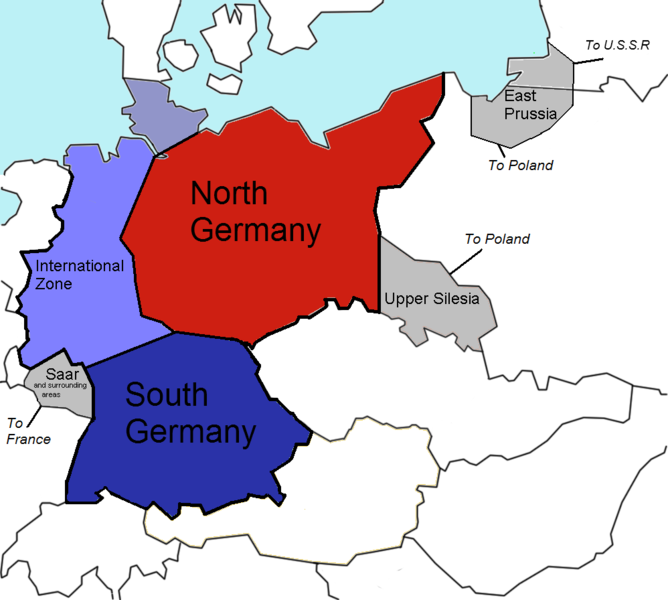
The Morgenthau Plan showing
the planned partitioning of Germany into a North State, a South State, and an International
zone. Areas in grey are areas intended for control by France, Poland
and the USSR.
Wikipedia - "Allied-occupied
Germany"
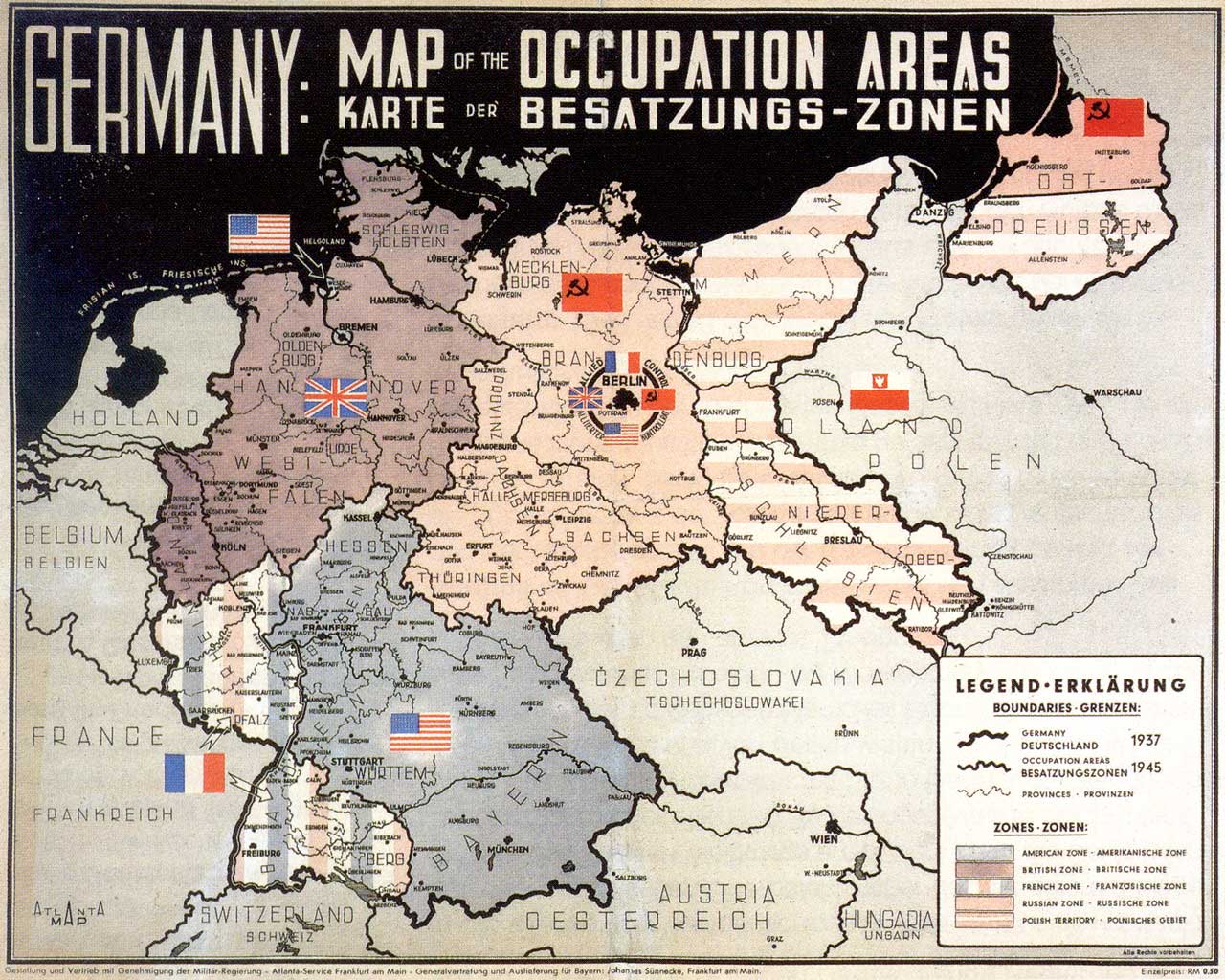
Official map from 1945 showing
the Allied allocation of the occupied German territories. Text is in English and German.
The territories east of the Oder-Neisse line that were granted to Poland
are here described as "Polish territory"
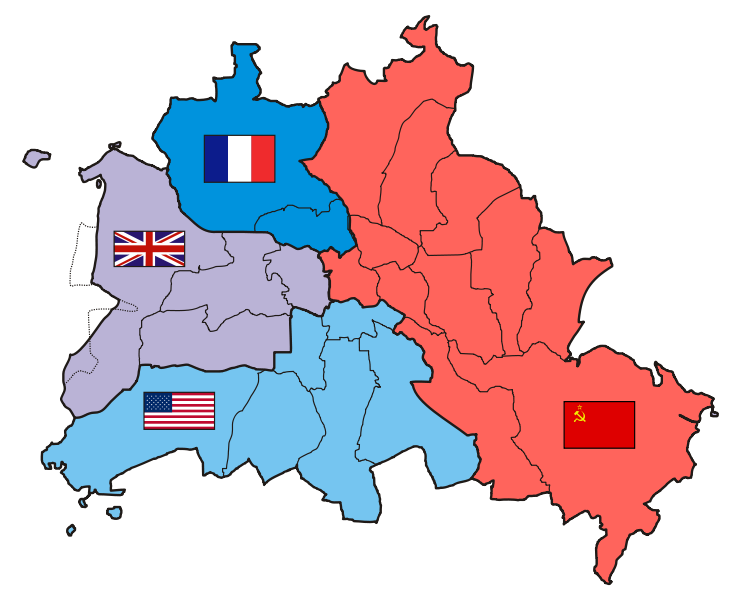 The four sectors of the occupied
city of Berlin (within the Russian zone of occupation however)
The four sectors of the occupied
city of Berlin (within the Russian zone of occupation however)
Wikipedia - "Allied-occupied
Germany"
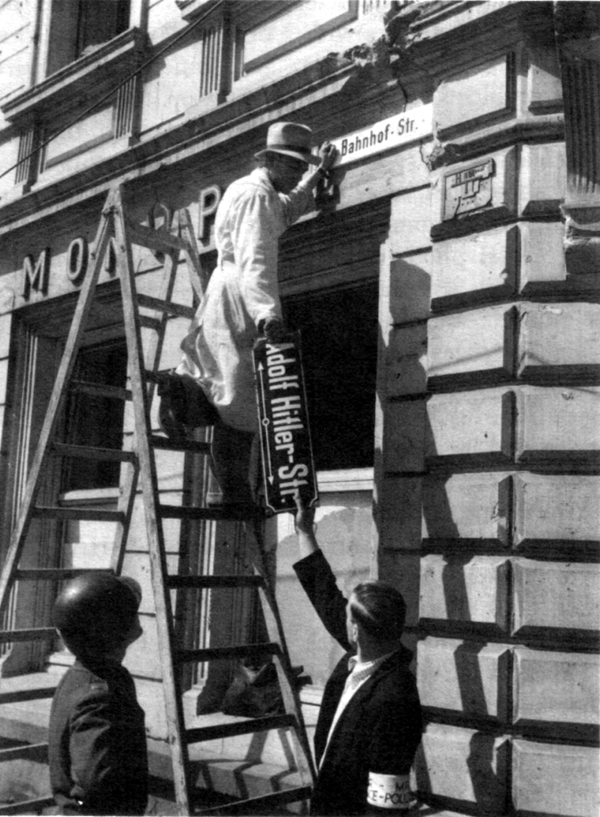 Workers removing the sign
from a former "Adolf Hitler Street"
Workers removing the sign
from a former "Adolf Hitler Street"
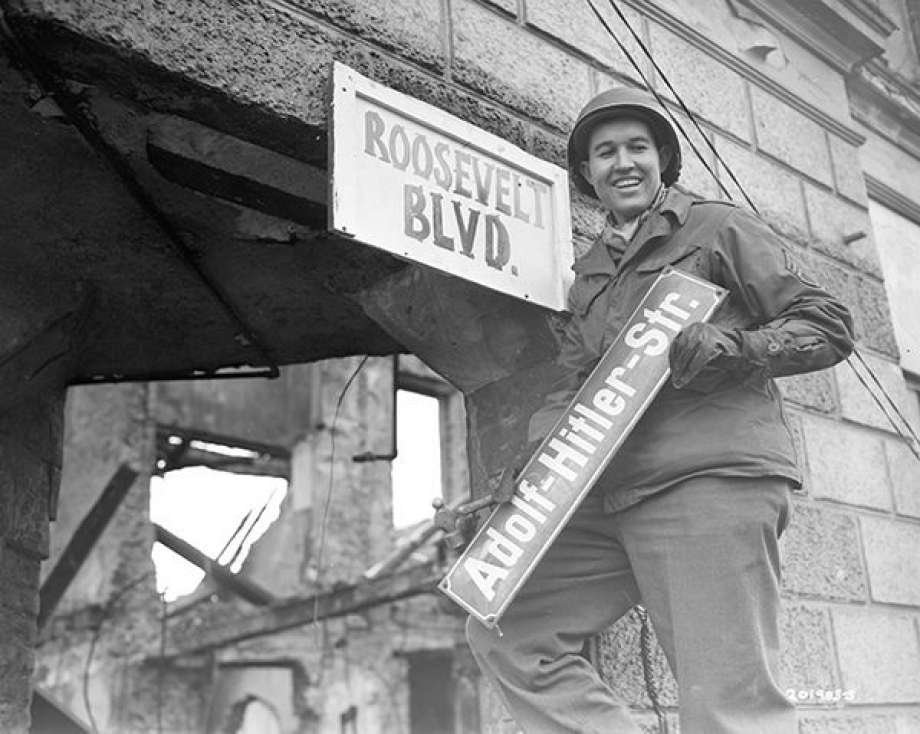
Mass migrations.
These territorial assignments meant that there would be millions of
Europeans that would find themselves now as "minorities" in newly
reconstituted nations. Millions of Germans now found themselves
at the mercy of the very people they had been so cruel and
condescending to. But Poles would find the certification of
Poland's East now as Soviet territory to be no less troubling.
Thus the roads of Eastern Europe were filled with refugees attempting
to escape the requirements of the Potsdam peace. Estimates are
that some 12-14 million people became just such migrants or "displaced
persons" (DP's), Germans moving in from Germany's lost lands in the
East (Poland, Czechoslovakia and Hungary). Most of those coming
to the Soviet-occupied zone tried to keep moving – until they arrived
in what they considered to be the more hospitable zones in the West,
zones administered by the British, French and Americans. But that
put an even greater burden on those same zones. In this move,
some 2 million of them simply died of hunger, exhaustion, or disease.
Then there were also some 8 million DPs in the former German
Reich who were non-German foreigners released from work and death camps
… confused about their future. And the death toll from this
horrible situation – from hunger, exposure, disease, and just local
mischief – was enormous … though the statistics are merely guesswork,
the lowest figures being somewhere around 5 to 6 hundred thousand … the
highest around 2 to 2.5 million. It was all very sad … the
results of a war that should never have happened in the first place.
The post-war German economy.
Not helping the situation any was the Allies' authorization for Russia
to rebuild its war-devastated industrial infrastructure – by receiving
$300 million in reparation payments from Germany … plus by stripping
the portion of Germany it occupied of whatever industrial items it
might find useful. This proceeded very rapidly – leaving
Soviet-occupied Germany with little by which to put itself back
together again – until the Soviets realized that they were creating a
situation in East Germany that threatened to make their occupation (and
desire to inspire Communism among German workers) totally
unworkable. So they slowed things down a bit.
The Western sectors undertook pretty much the same program of stripping
Germany of whatever industrial items it might find useful … but also
slowed up when they came to the same conclusion as the Soviets about
this kind of policy. In fact, in the French sector, the French
authorities actually encouraged the Germans to get back to the business
of farming, coal mining and steel manufacture … actually very
beneficial to French industry and its own profitability. Things
picked up quickly in this sector … noted carefully by the occupational
authorities – at least in the West.
|
German citizens now struggle to find ways to survive
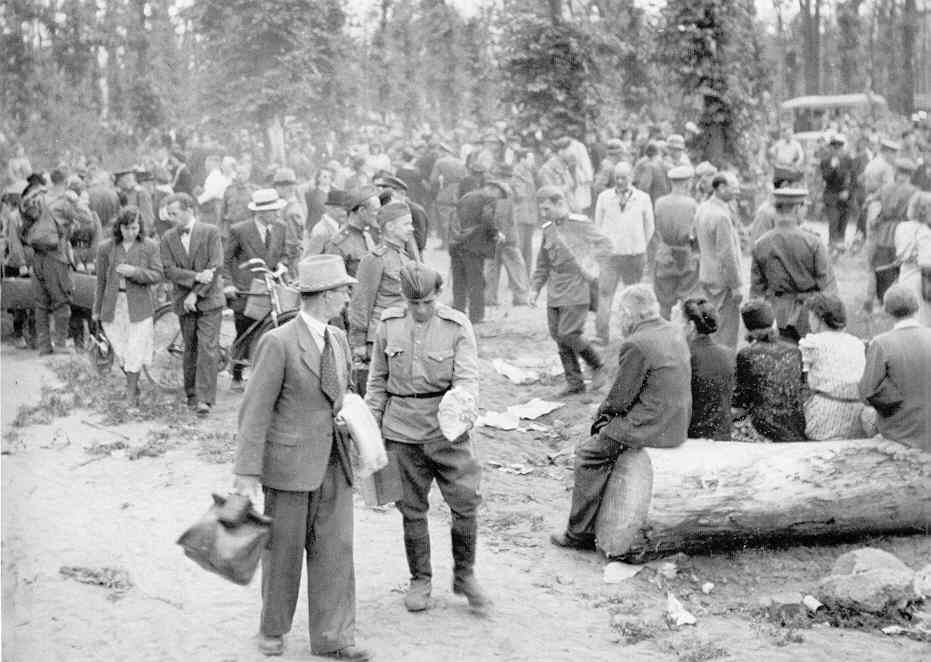
Black-market trading between
soldiers and civilians - Berlin Tiergarten - summer 1945. Cameras, household goods
and hierlooms were traded for money or cigarettes - to then purchase scarce
food
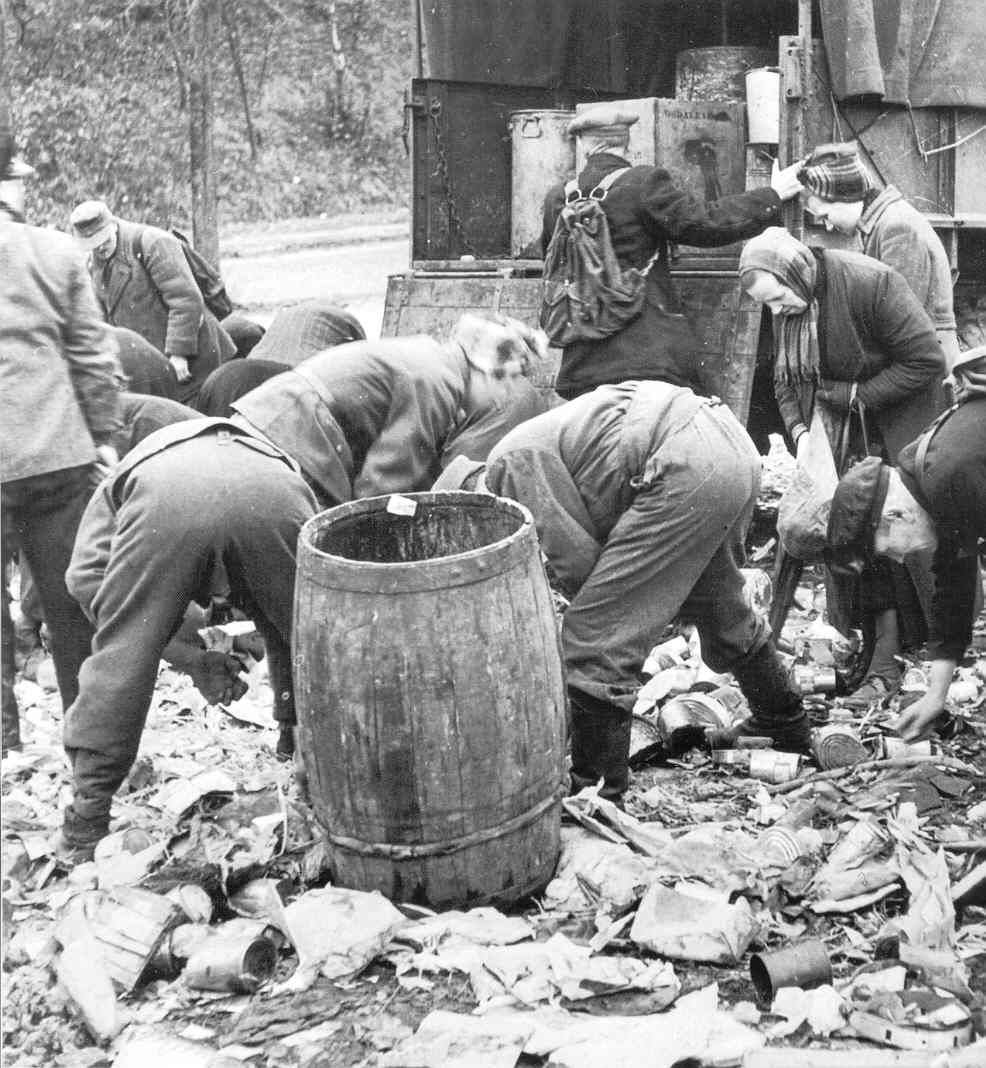
Berliners looking for anything
of value that can be used for barter
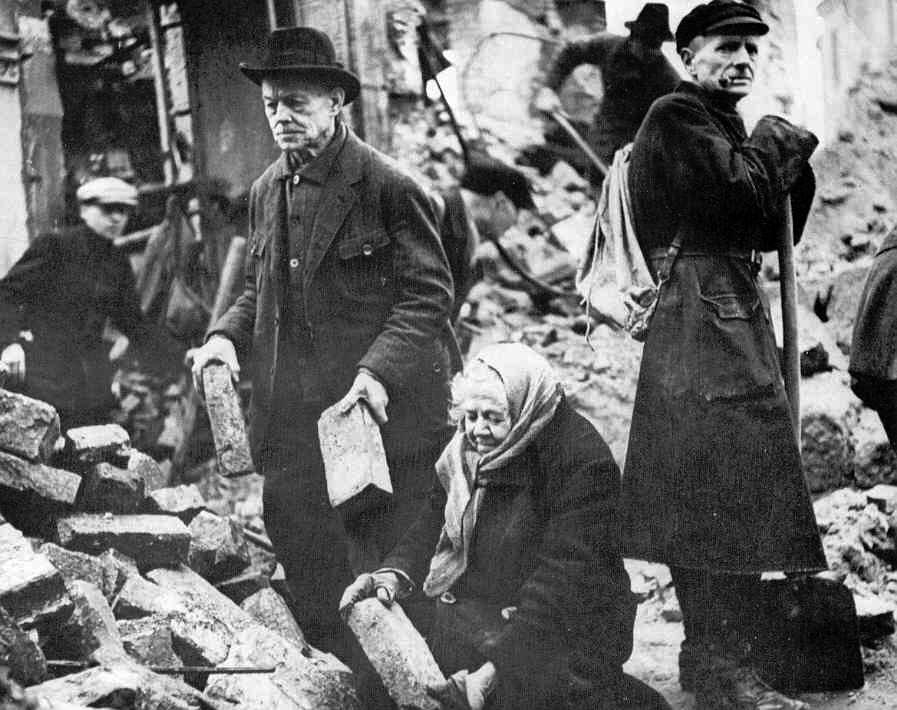 Citizens of Dresden sorting
out useable brick and stone as a volunteer effort to rebuild Germany
Citizens of Dresden sorting
out useable brick and stone as a volunteer effort to rebuild Germany
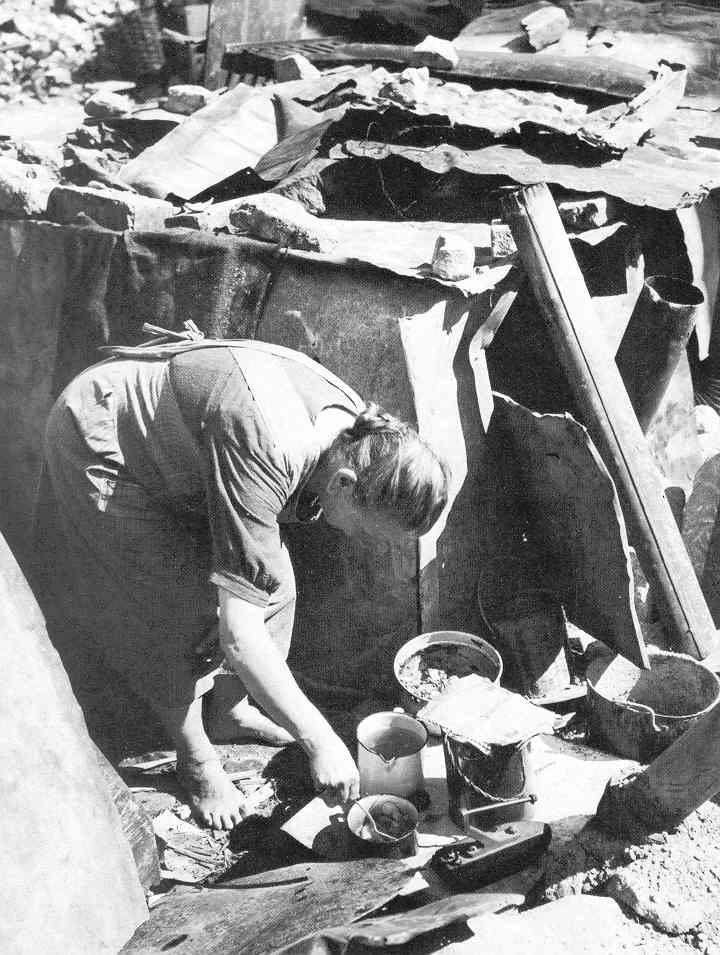 A woman in Nuremberg in a
makeshift home cooking a mix of apples, potatoes and greens
A woman in Nuremberg in a
makeshift home cooking a mix of apples, potatoes and greens
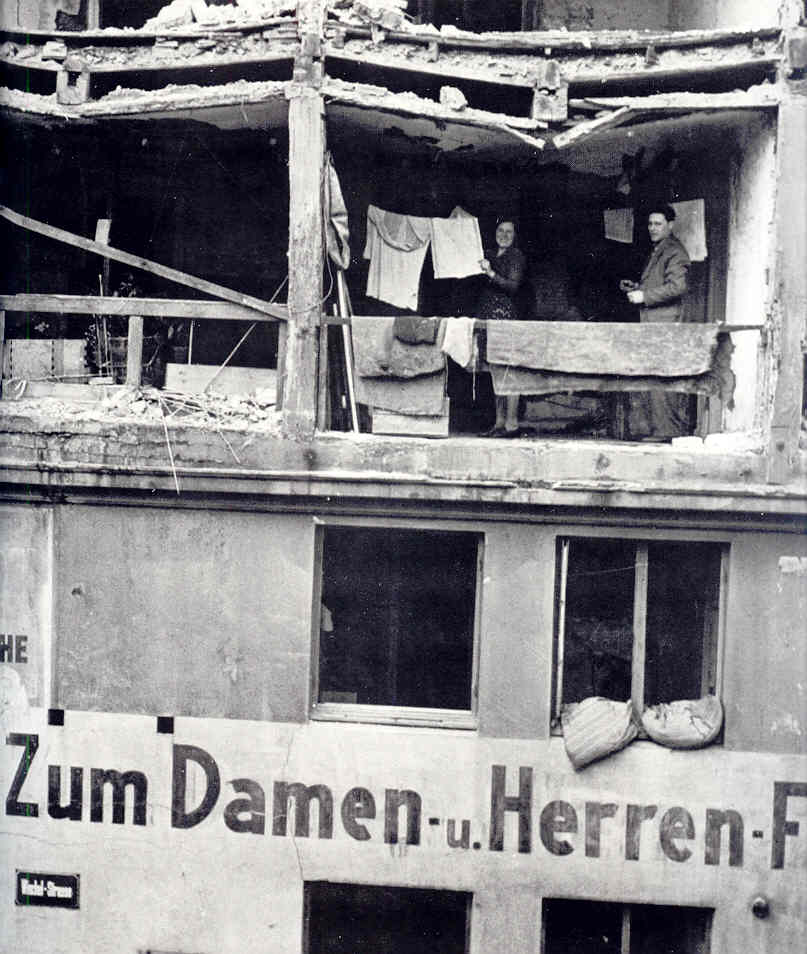 Makeshift life in
Hamburg
Makeshift life in
Hamburg
Imperial War Museum,
London
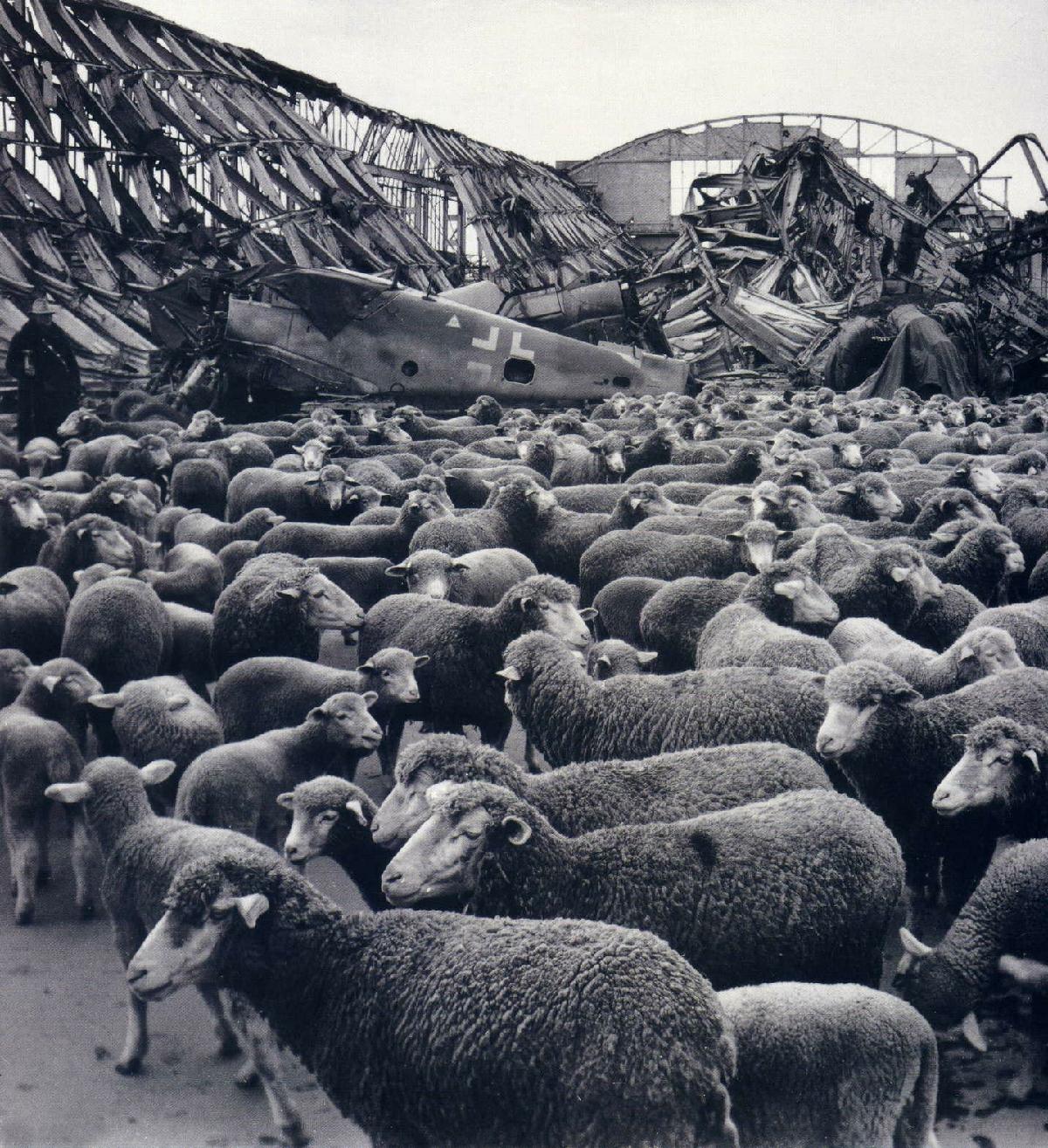 Sheep resuming a normal life
in a bombed out hangar in Leipzig. One quarter of the city was totally flattened
by Allied bombing
Sheep resuming a normal life
in a bombed out hangar in Leipzig. One quarter of the city was totally flattened
by Allied bombing
A typical tragedy awaiting refugee Germans
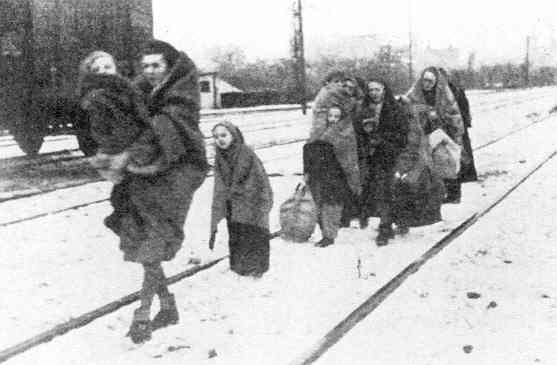
A small group of German women
and children arriving in the British sector of Berlin - October 1945 - the sole survivors of 150
who were expelled from Lodz, Poland, 270 miles away. The mother in front is striding
out ahead, anxious to get help for her 3-year old son.
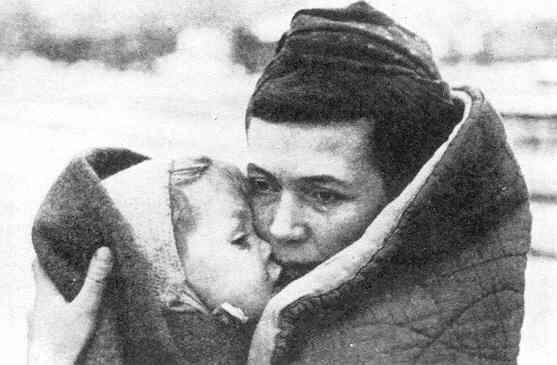 The mother clasps the son
to keep him warm – and then realizes that her son has just died.
The mother clasps the son
to keep him warm – and then realizes that her son has just died.
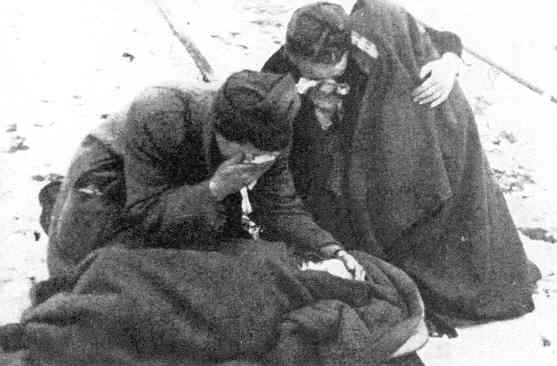 The women grieving as the
boy's head is pillowed on a railroad track
The women grieving as the
boy's head is pillowed on a railroad track
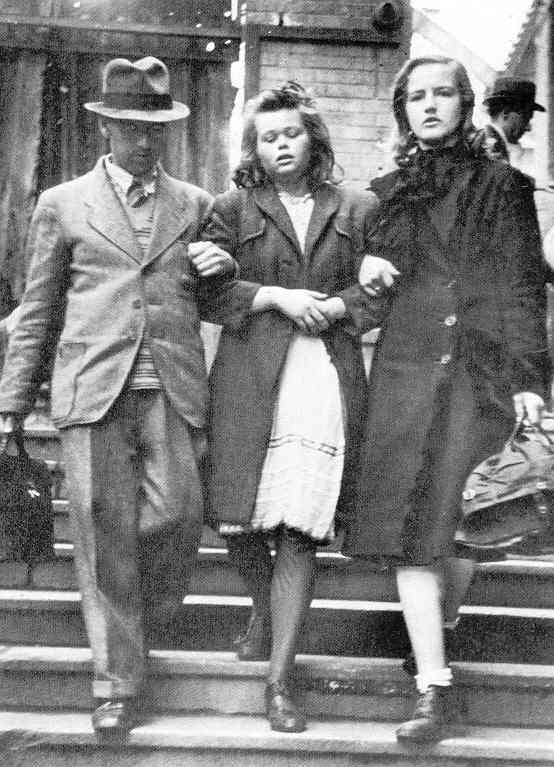
A German girl being led from
a Berlin train station – having been gang-raped by
Polish youths (typically, war orphans) who regularly boarded trains
to rob or rape German refugees fleeing Poland
Nonetheless, the Germans do their best to move life ahead
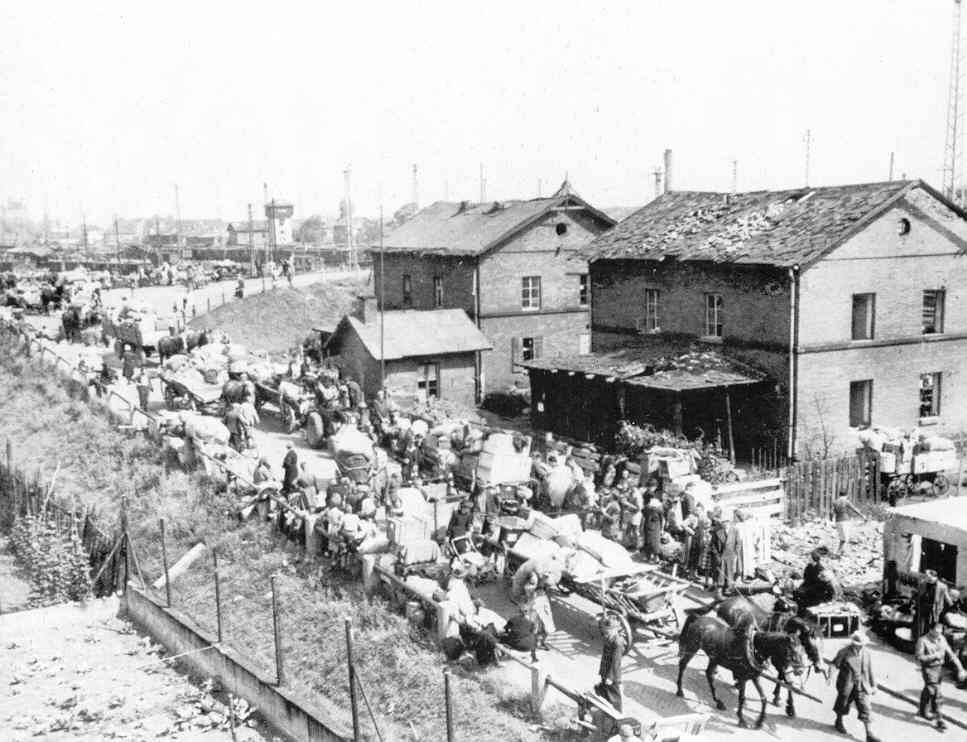
German farmers and miners
gathering with families and possessions to move from the horribly overcrowded American sector to the French sector where skilled labor was
actually in short supply
National Archives
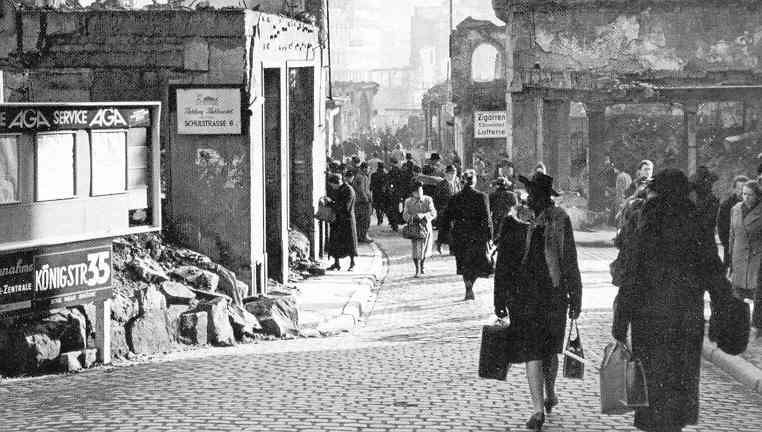
Some citizens of Cologne,
Germany, resuming as much a normal life as possible - though for most, life amounted
to a constant search for food, shelter, and clothing - 1946 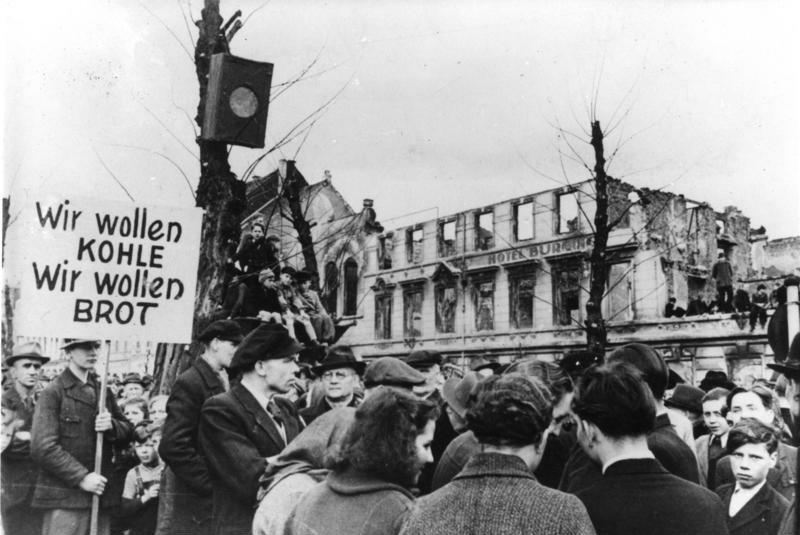 The long winter of discontent:
1946-1947. Citizens of Krefeld Germany protesting, in demand for food and fuel
(March 1947)
The long winter of discontent:
1946-1947. Citizens of Krefeld Germany protesting, in demand for food and fuel
(March 1947)
Bundesarchiv
183-B0527-0001-753
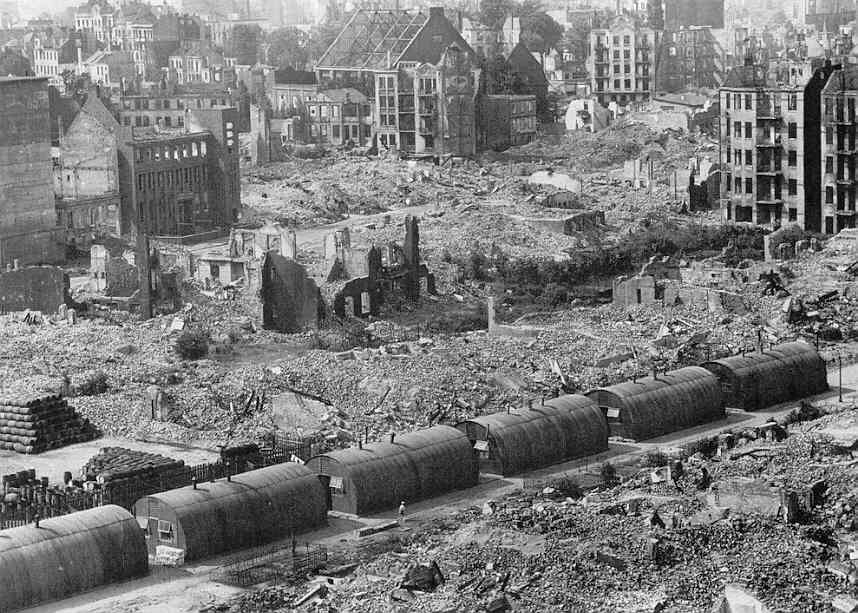 And recovery was not quick:
Hamburg still in Ruins - 1947
And recovery was not quick:
Hamburg still in Ruins - 1947
THE NUREMBERG
WAR CRIME TRIALS (November 20, 1945 - October 1, 1946) |
Bringing the former Nazi leaders to justice.
There still remained the matter of what to do about the worst of the
Nazis. Hitler and his mistress Eva Braun and Hitler's
propagandist, Joseph Goebbels (and family) had solved that portion of
the problem with their suicides. But subsequently, 24 others were
arrested, imprisoned, and then put on trial in November of 1945.
Air Marshal Hermann Göring committed suicide during the trial and Labor
leader Robert Ley had done so prior to the trial … leaving twelve
others ultimately to be hanged, seven given lengthy prison sentences
(three for life) and three were ultimately acquitted. And with
that, the matter of bringing Germany to justice for its behavior came
to something of an end (there would be many local acts of "justice" of
course that would take place). There were new challenges to be
dealt with.
Securing "justice" with other Axis nations.
Italy made the matter a lot easier with its own capture and execution
of dictator Mussolini, his mistress Clara Petacci, and several other
Fascist notables just prior to the end of the war. And Italy was
outside the realm of actual Soviet military occupation … simplifying
matters greatly in getting Italy pieced back together again.
In any case, an all-important Allied meeting was held in Paris
(July-October) to work out "justice" for the Axis nations Germany,
Italy, Austria, Romania, Bulgaria, Hungary and Finland. This was
when the $300 million German reparations payment was decided.
Russia demanded a similar reparations payment of $300 million from
Italy … which was turned down by the Western allies. Russia also
wanted the Italian colony of Libya – nicely located on the southern
shores of the Mediterranean. But that too was an idea that got no
support from the Western Allies.
Nonetheless, allies Yugoslavia, Czechoslovakia and Greece were
recipients of reparations payments ... plus territorial exchanges taken
from Italy and Austria. Thus in the end, even the Italians had to
come up with reparations payments: $100 million to Soviet Russia,
$105 million to Greece and $125 million to Yugoslavia.
And most cruelly, Finland, a country that had been invaded by its
neighbor Russia during the opening days of the Stalin-Hitler alliance –
a Soviet invasion condemned by the League of Nations – which led
Finland subsequently to look to Hitler's German for protection … was
therefore forced to pay Russia $300 million in various reparation forms
and surrender border territory to Russia for its "crimes." |
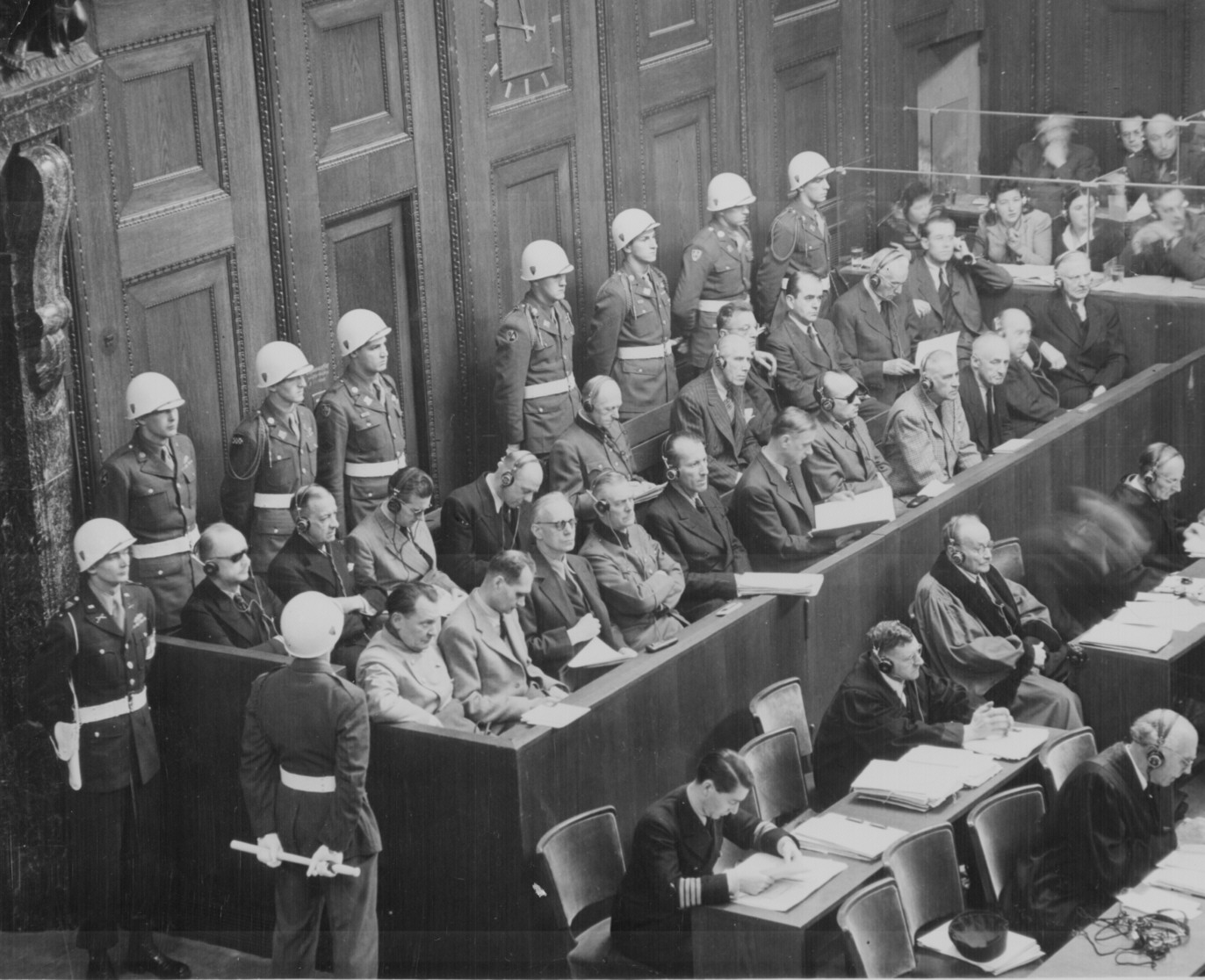
Nuremberg War Crimes Trials: looking
down on the defendants' dock. ca. 1945-46
National Archives
238-NT-592.
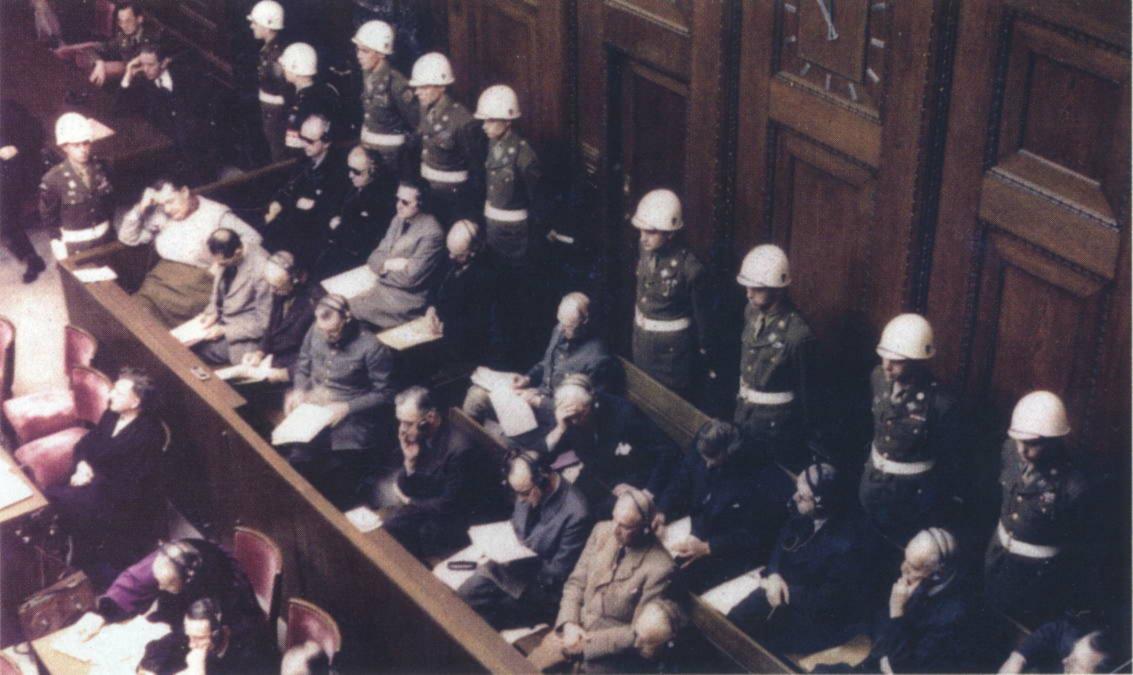
The Nuremburg Trial - Palace
of Justice
National Archives
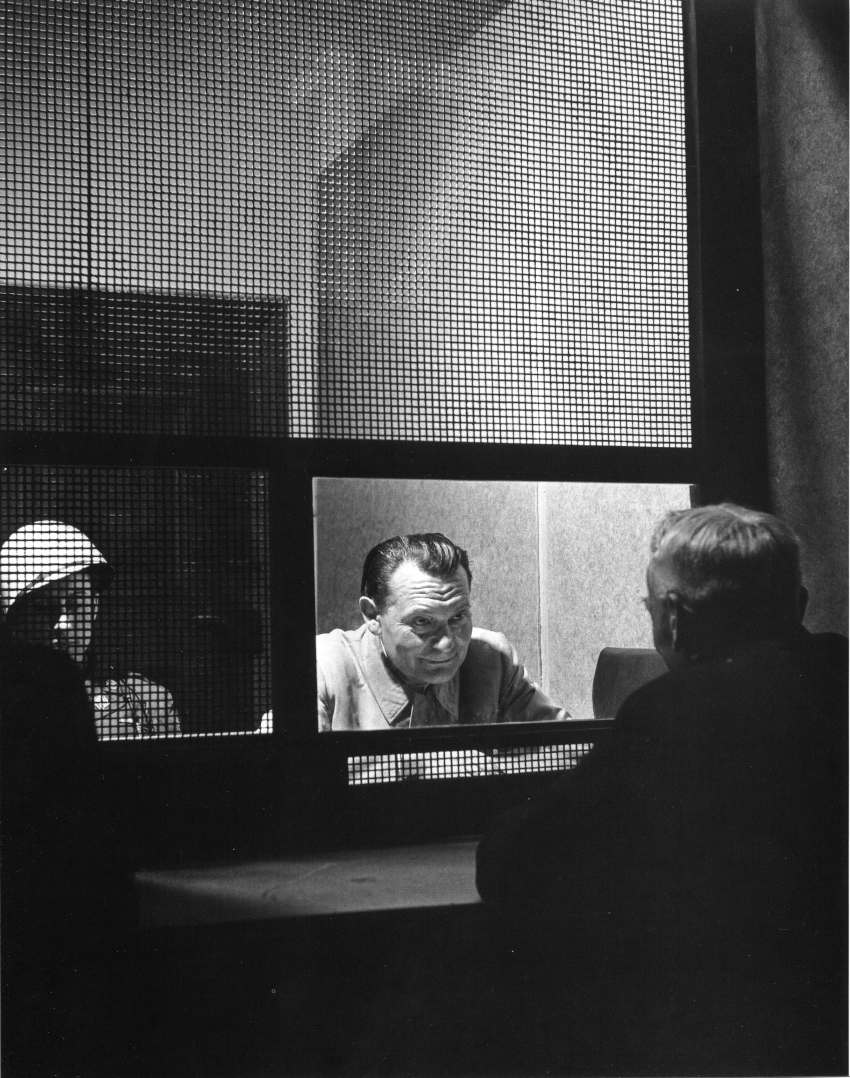
War-criminal Göring
being interviewed in prison
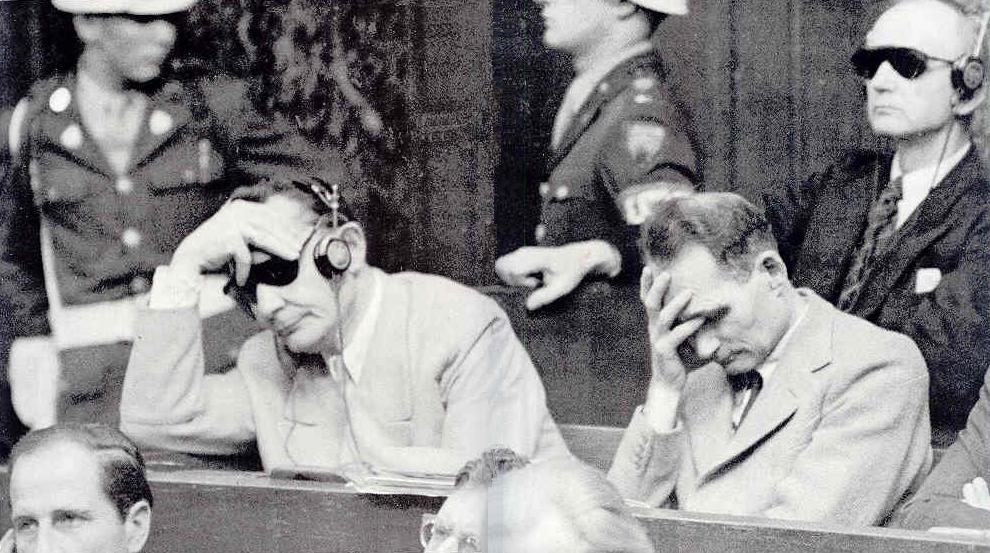
Göring,
Hess and Dönitz hear their sentences -
September 30, 1946
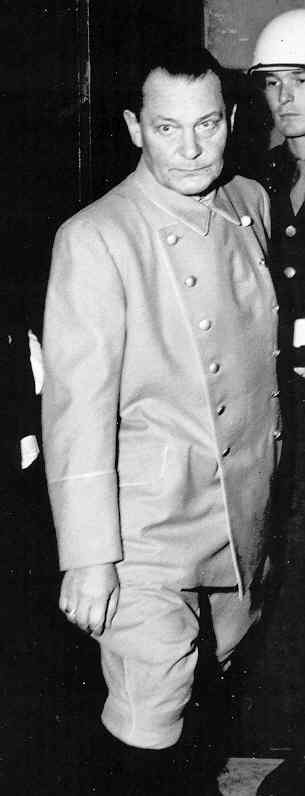
Reich Marshal Hermann Göring
Committed suicide shortly
before
his scheduled
hanging
|
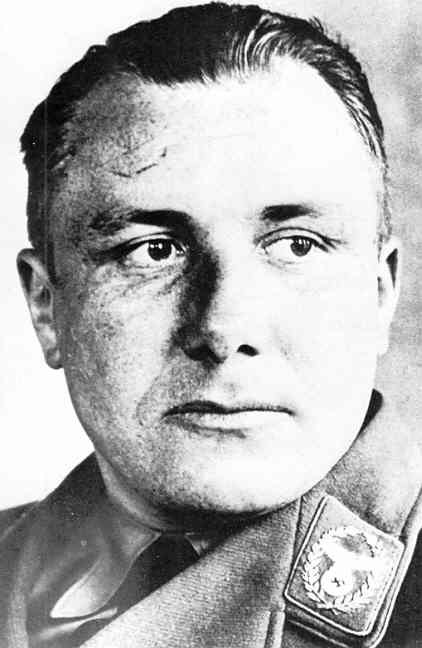
Martin Bormann
Hitler's Special Assistant
Condemned to death in
abstentia
His body was discovered
in Berlin in 1972 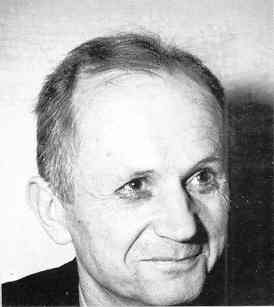
|
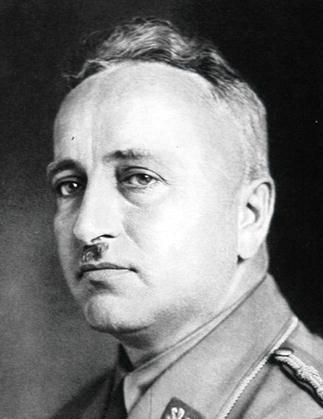 Robert
Ley
Nazi Labor leader
hanged himself in prison
during the trial
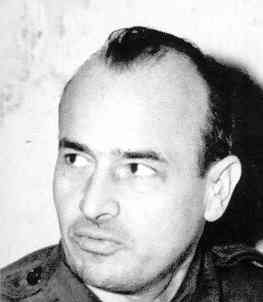
|
|
Grand Admiral Karl Dönitz
U-boat commander / Navy
Chief
Sentenced to 10 years
imprisonment
|
Hans Frank
Minister of Justice /
Governor-General of Poland
Death by hanging - Oct.
16, 1946
|
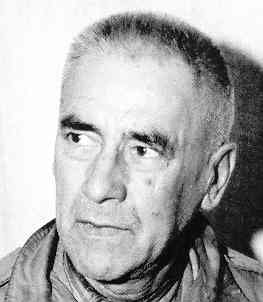
|
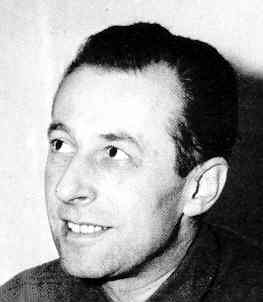
|
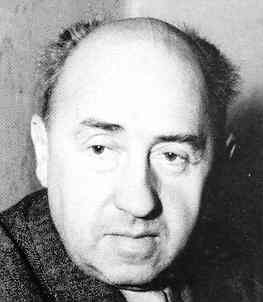
|
Wilhelm Frick
Interior Minister /
"Protector" of Bohemia and
Moravia
Death by hanging - Oct.
16, 1946
|
Hans Fritzsche
Radio Propagandist /
Deputy to Joseph Goebbels
Acquited of war crimes
/
later received
short sentences
for lesser crimes
|
Walter Funk
Successor to Schacht as
Reichsbank President
sentenced to life
imprisonment
|
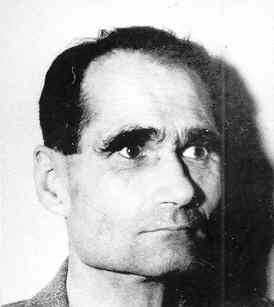
|
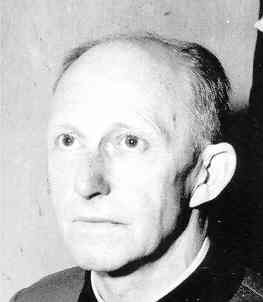
|
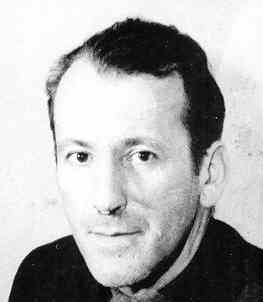
|
Rudolf Hess
Deputy Führer until
his flight to England in 1941. Sentenced to life
imprisonment
|
General Alfred Jodl
Chief of Operations of the
High Command
Death by hanging - Oct.
16, 1946
|
Ernst Kaltenbrunner
Himmler's Assistant /
Chief of Central Security
Services
Death by hanging - Oct.
16, 1946
|
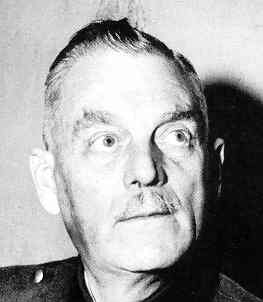
|
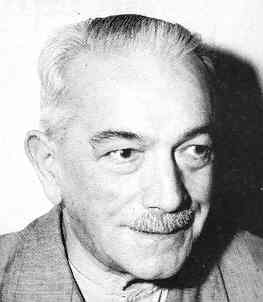
|
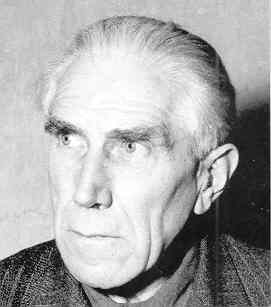
|
Field Marshall Wilhelm Keitel
Chief of Staff of the High
Command
Death by hanging - Oct.
16, 1946
|
Constantin von Neurath
Diplomat and "Protector"
of
Czechoslovakia
Death by hanging - Oct.
16, 1946
|
Franz von Papen
Former Chancellor / Ambassador
to Turkey
Acquited of war crimes
/
later received short sentences
for lesser crimes
|
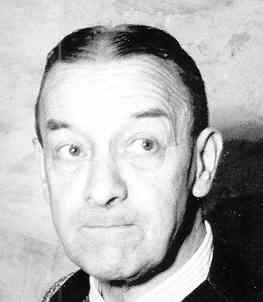
|
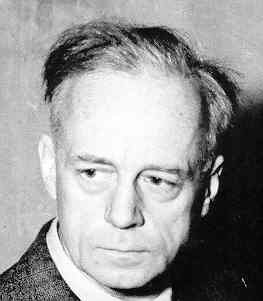
|
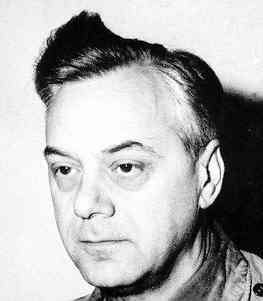
|
Grand Admiral Erich Raeder
Head of German Navy until
1943
Sentenced to life
imprisonment
|
Joachim von Ribbentrop
Foreign Minister
Death by hanging - Oct.
16, 1946
|
Alfred Rosenberg
Minister for the Occupied
Eastern Territories
Death by hanging - Oct.
16, 1946
|
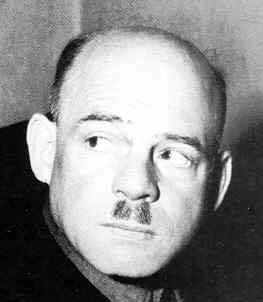
|
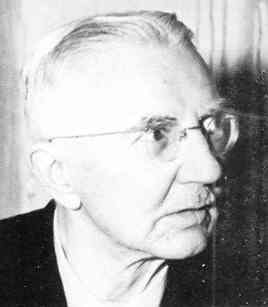
|
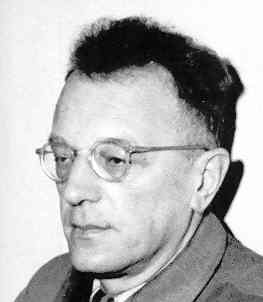
|
Fritz Sauckel
Manpower organizer/procurer
of slave labor
Death by hanging - Oct.
16, 1946
|
Hjalmar Schacht
Reichsbank President / Economics
Minister
Acquited of war crimes
/ later
received short sentences
for lesser crimes
|
Arthur Seyss-Inquart
Commissioner for the
Netherlands
Death by hanging - Oct.
16, 1946
|
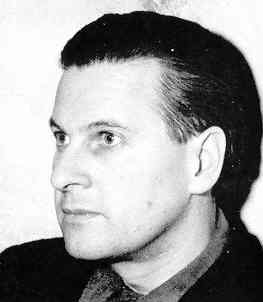
|
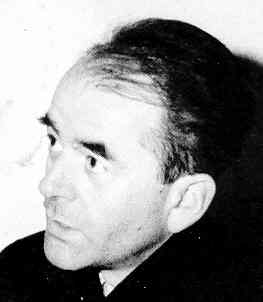
|
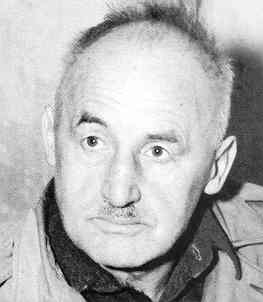
|
Baldur von Schirach
Hitler Youth Leader / Gauleiter
of Vienna
Sentenced to 20 years
imprisonment
|
Albert Speer
Chief Nazi Architect / Production
Minister
Sentenced to 20 years
imprisonment
|
Julius Streicher
Anti-Semitic editor of Der
Stürmer /
Gauleiter of Franconia
Death by hanging - Oct.
16, 1946
|
DEALING WITH POST-WAR JAPAN |
|
Taking over the former Japanese Empire
The Russians had come into the war effort in China so late
(entering only one week prior to its termination) that they would have
little voice in how the post-war Japanese Empire was to be
administered. They did get the promised territory in North Korea
and Manchuria. But they had no real say in matters beyond
that. The French and Dutch had been so badly weakened by the war
that, although they certainly were looking forward to regaining their
imperial territories in Southeast Asia, they would have a hard time
realizing those particular goals. As for the British, having come
under Clement Attlee's British Labour Party, they would instead take a
rather anti-imperialist path … having long believed (the Labour Party
anyway) that Britain's economic activities in imperial India actually
undercut employment back in Great Britain. Therefore, the best
policy for Britain was to step back from its former imperial
role. Ironically, they failed to realize that economic relations
with India were vital to British industrialism – including very
importantly jobs for British workers. But the Labour Party was
ideologically blind to this fundamental economic reality.
Thus, basically the overall management of Japan's former empire would
fall to America … whether it wanted this post-war responsibility or
not. Most Americans had little concern about the sad state of
post-war Japanese society. They did feel however that Japan
should be brought to justice … in particular Emperor Hirohito, who
directed the murderous Japanese military during the war.
But both President Truman, and General MacArthur (the latter in command
of occupied Japan) knew that managing post-war Japan would be
exhausting if they did not have local leadership assisting them in this
endeavor. And getting help from the emperor himself would greatly
facilitate the occupational effort. Thus talk of imprisoning and
probably executing the emperor was blocked by both Truman and
MacArthur. Indeed, MacArthur was sent off to Japan to see if he
could bring the emperor into American plans.
There were conditions associated with the emperor’s
"forgiveness." He would have to give up the pretense of being
some kind of "god" … and become more "democratic" (as America
understood the term) in his dealing with his people. And indeed,
the emperor seemed most willing to make this switch in his role, even
heading out to be among the people at various events – even just taking
walks in the streets of Japan’s local communities in order to meet his
people.
Actually, the Japanese people themselves seemed to switch their
feelings about the Americans from hatred to acceptance – and even a
willingness to learn from those Americans who now stood over
them. Also, MacArthur was himself quite familiar with Asian ways
(his earlier career having given him much time spent there), and was
well familiar with what Asians wanted in their leadership: an
individual strong, noble and visibly concerned about the welfare of the
people under him. Thus MacArthur, in taking up exactly that role,
was able to bring himself comfortably alongside Hirohito ... in a way
that made it appear that Japan had "two emperors." This worked
very well for the Japanese.
Thus it was that administering post-war Japan turned out to be a
very simple, straightforward task for the American occupation.
Bringing the former Japanese leadership to justice
Nonetheless there still remained the question as to what should be done
with other portions of Japan's leadership, notably its military
leadership … which had been quickly rounded up in Japan in the days
just after the war's end. Finally, MacArthur set up a military
tribunal in Japan to hear the cases of some 28 individuals, testimonies
running from May of 1946 to November of 1948. Ultimately, seven
defendants (including Tojo) were sentenced to death by hanging, and 16
defendants were sentenced to life imprisonment. However,
America's allies also held local trials here and there in Asia of
mostly lower-ranking military officials … resulting in over 5,000
convictions and nearly 1,000 executions.
|
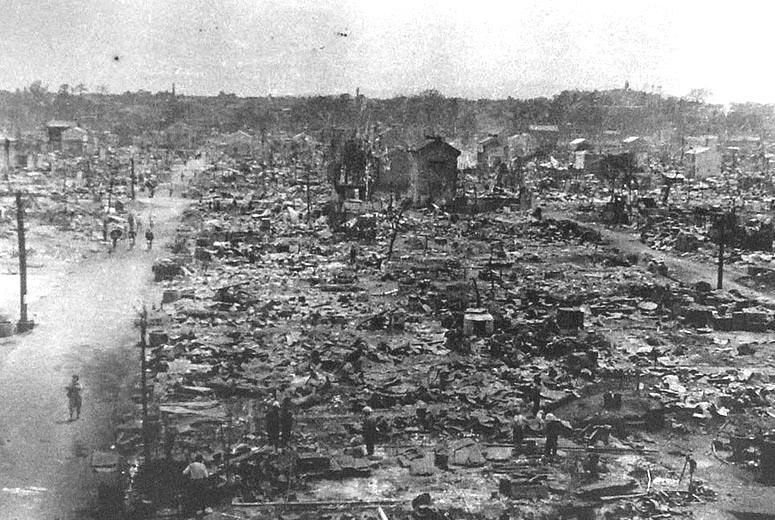
Tokyo ... after the firebombing of March 1945
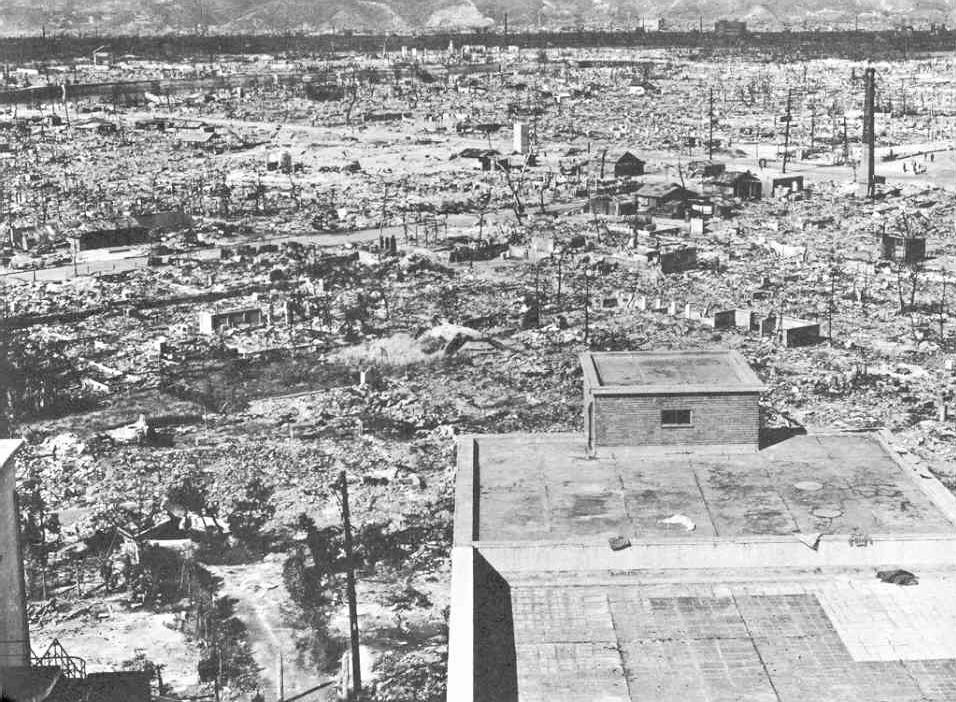
Devastated Hiroshima -
1945
U.S. Air Force
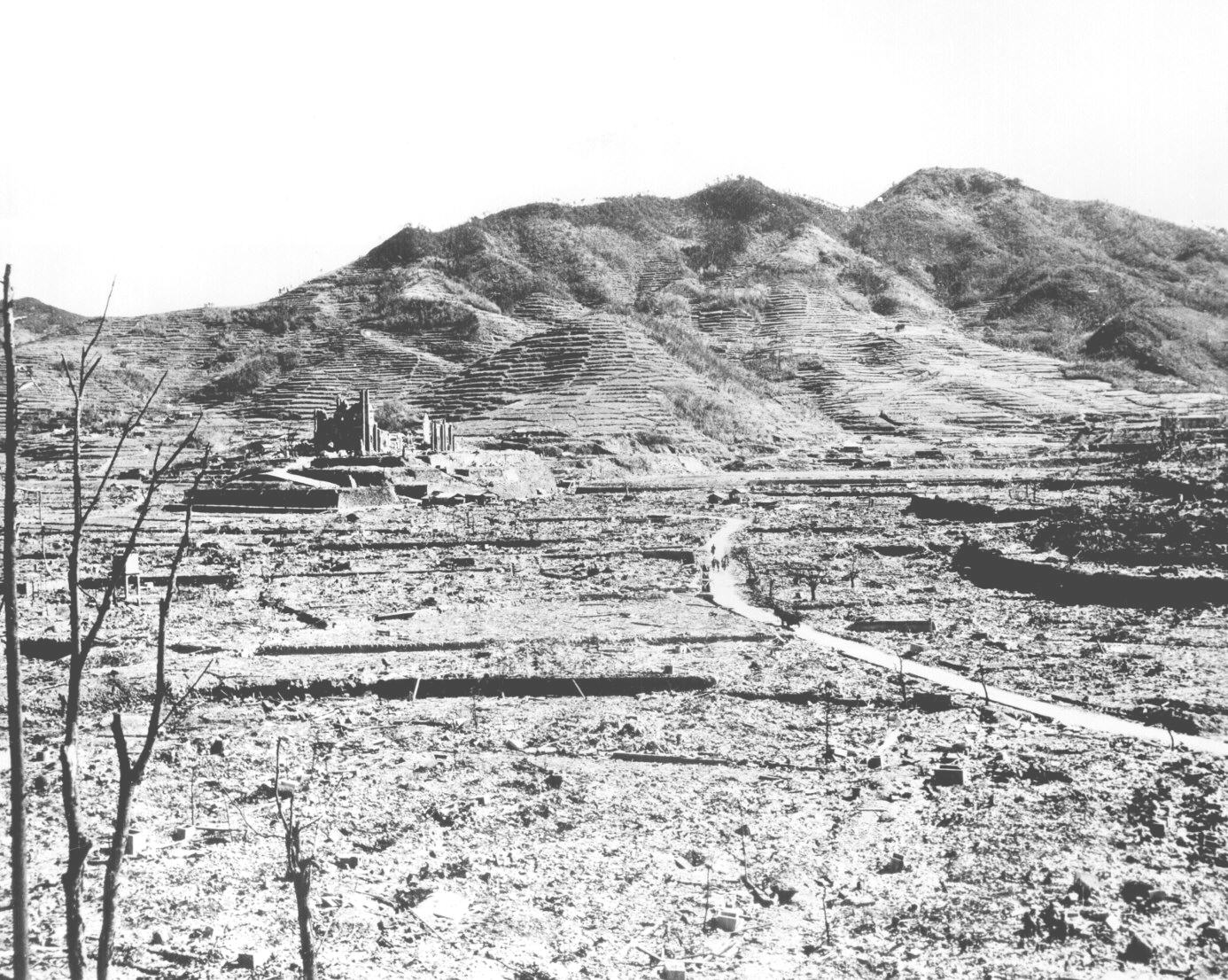
In the background, a Roman Catholic
cathedral on a hill in Nagasaki. ca. 1945
National Archives
77-AEC-52-4459
Japan, though bombed thoroughly, found
the occupation of their country by their once-enemy to be less traumatic
than it proved to be for Germany
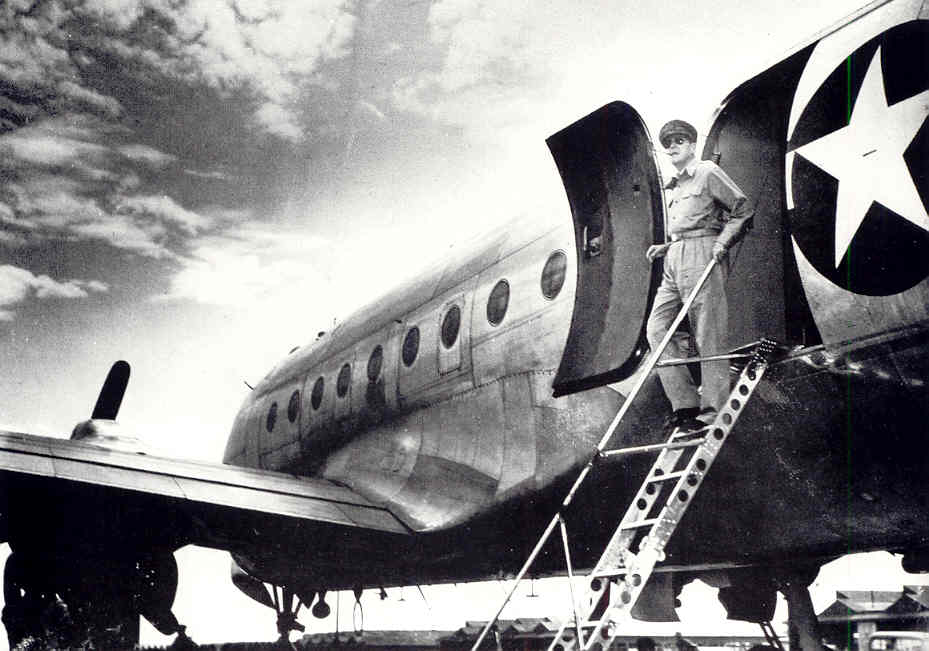
MacArthur arrives in Yokohama,
Japan - August 30, 1945
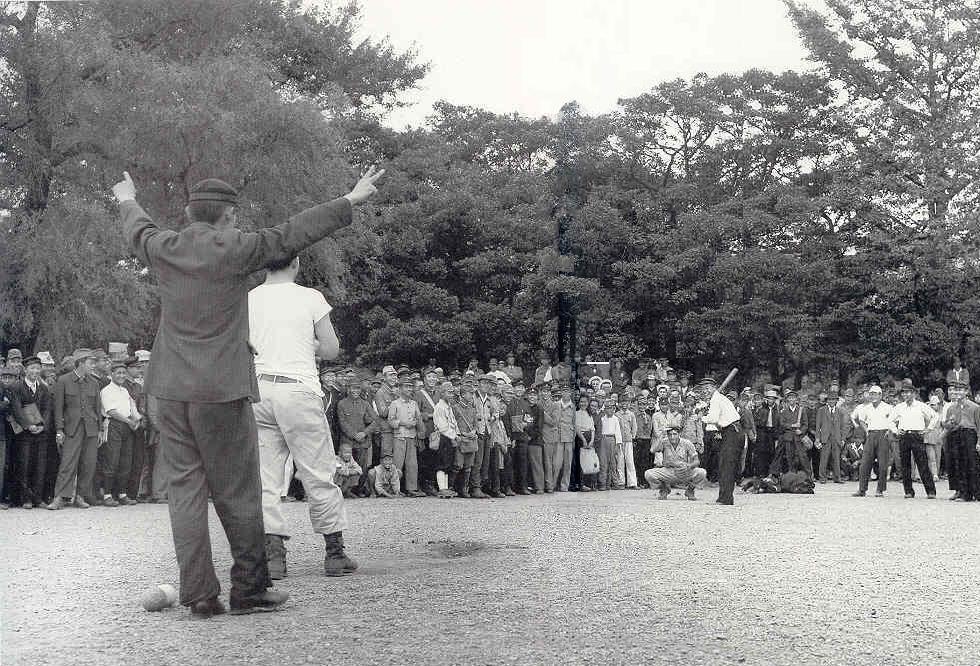
American GIs playing softball
with a Tokyo team in October 1945 – only two months after the
end of the war
U.S. Army
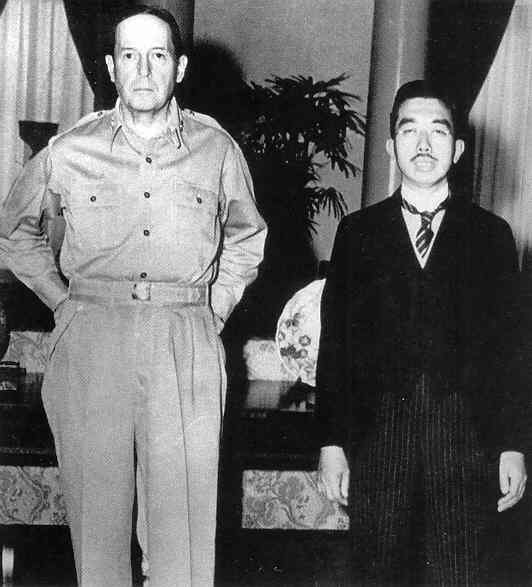 Supreme Commander Douglas
MacArthur and Japanese Emperor Hirohito - 1945
Supreme Commander Douglas
MacArthur and Japanese Emperor Hirohito - 1945
National Archives
NA-208-N-46403-FA
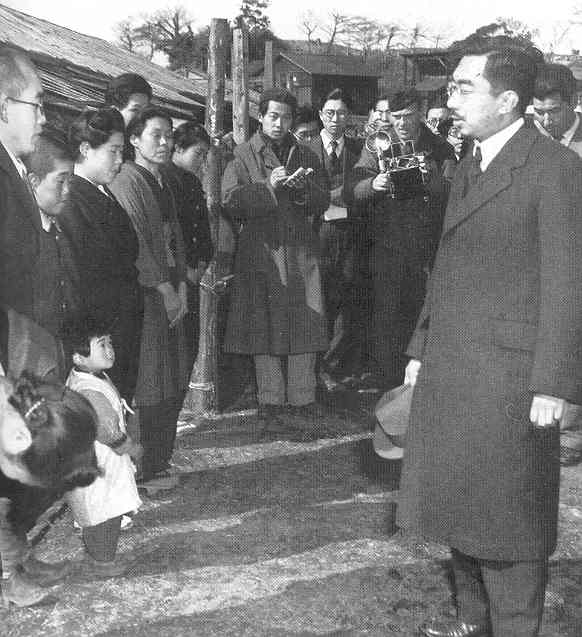
The man once considered a
god, Emperor Hirohito, meets with residents of a new housing project near
Tokyo – part of the
democratization
of Japanese authority
U.S. Army
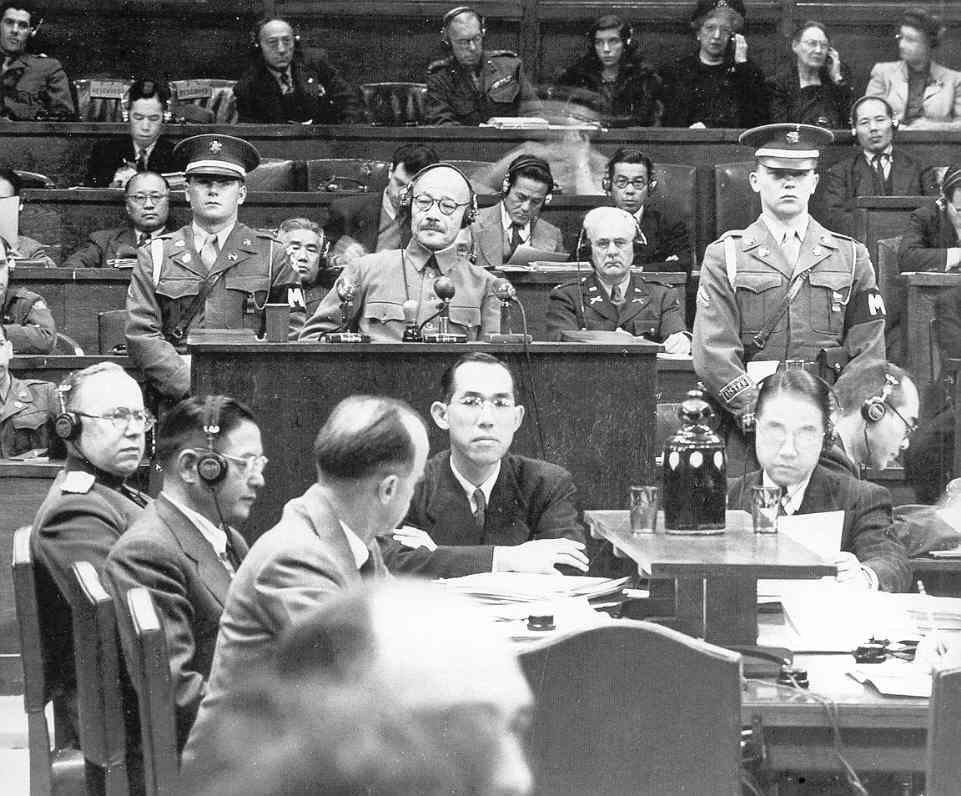
Japanese wartime leader, General Tojo's war-crimes trial
|
Labor issues
The war had smoothed over former ideological antagonisms separating
American capitalists and the American workers … bringing
Depression-scorned capitalism back into national favor … but also labor
union membership and labor wages growth also to new heights. And
war-time patriotism had kept both groups working in harmony. But
now with the war over, old attitudes began to resurface … especially
with the huge concern over the direction America's post-war economy
might take. What now would happen when the postwar world no
longer needed the goods produced by America's massive war
industry? And what would the "boys coming home" from the war find
by way of work? Would America sink back into the Great Depression?
Indeed, during the period 1945-1946, America was hit with a wave of
labor union strikes, involving around five million workers – angry at
the job reductions that accompanied the shutting down of America's
industrial war machine. But a number of factors would quickly
bring America out of this contentious mood … well in advance of the
developments found elsewhere in the postwar world. It was a
similar labor turmoil abroad that America was witnessing that began to
put questions in American minds … as it became increasingly clear that
this labor strife was not just about jobs – but about political
takeovers … notably by the Moscow-directed Communists, active
everywhere. American labor definitely did not want to be
identified with any of that … especially when the Cold War began to
crank up (1947 and after).
Republican Party gains
Actually, this played strongly into the hands of "Middle America" … and
also fed the huge Republican Party sweep of post-war elections across
the country – and brought Congress under a strong Republican Party
majority. And that in turn led to the passage in 1947 of the
Taft-Hartley Act, overturning the pro-labor Wagner Act of 1935 and
placing America's labor unions under a number of restrictions.
Truman vetoed the bill … but Congress's 2/3rds vote overrode his veto.1
The G.I. Bill
But a kinder approach to the unemployment problem had already been put
in place with the passage of the Servicemen's Readjustment Act of 1944
– popularly known as the "G.I. Bill." The government offered
veterans free education – either college or technical school – covering
both tuition and expenses. This gave returning G.I.s ("Government
Issue"!) a great alternative to unemployment … actually building
considerably America's skill-level nationally. It was a very wise
government investment … and a way for young Americans to achieve the
American dream: to train for work that would bring them to full
membership in Middle America.
The huge consumer market
Also, and most importantly, American industry was quick to turn to the
mass production of low-cost consumer goods … ones whose production had
been abruptly halted with America's entry into the war in order to
focus American industry on war production. For instance,
virtually no American automobile production took place during the war
years (building trucks and tanks instead of sedans!).
Consequently, there was a huge buildup in the postwar demand for cars,
refrigerators, washing machines, etc. This was especially the
case for single-family homes … which in the post-war period were
constructed in the thousands, hundreds of thousands even! Low
interest mortgages and personal loans (again, thanks to the G.I. Bill)
made all this very accessible to young Americans.
This dynamic also reached deeply down into America's labor segment …
which also very quickly saw for itself the open path to Middle American
membership … softening considerably American labor-management
tensions. Thus Middle America, which now included most all
Americans (except most tragically, American Blacks), found itself
flying high.
Vets and Boomers
Something else that had been put aside during the war were marriages
among young Americans. But with the return from the war of
hundreds of thousands of veterans – or "Vets" as they can be properly
termed as a generation-group – that shortfall was corrected
immediately! And with that (beginning at least 9 months later!)
there occurred a huge explosion in the number of births in America … a
literal "Baby Boom."
But this would produce a new generation of young Americans who would
differ greatly – radically so – from their parents in how they
understood and went at life. The parents of these "Baby Boomers"
– the "Vets" – were a tough breed … having their own growing-up years
take place during the Great Depression. And then as young adults,
they were called to intense patriotic duty in the war ... offering
themselves, even the possibility of forfeiting their lives, in service
to the nation's call. Indeed … these Vets would come to be
identified (and rightly so) as "the Greatest Generation" – providing
the last huge step in bringing America itself to greatness.
But their Boomer children will come to know virtually nothing of such
larger social service … growing up materially in the very best of
times, lacking nothing, even indulged greatly by their Vet parents –
who remember their own shortages and suffering in their younger years …
and want none of that for their children. Thus the Boomers will
grow up (entering adulthood in the mid-1960s) as a very "entitled"
generation … naturally assuming that life will always owe them the kind
of security and material payoff they experienced growing up.
Self-sacrificing for the greater good will not register with
them. Their world will center on themselves, their personal
rights, their personal freedoms. Society will just have to take
care of itself. Better yet, the government can do that for
them. To the Boomer, that becomes the very purpose of
government: to continue to provide the care they experienced at
home growing up. Somehow this is what life owed them.
On the other hand, having just gone through the most challenging of
times, the Vets made no assumptions that they themselves were
automatically entitled to life's blessings ... or that they personally
held the solutions to life's challenges. The design of the war,
the nation's economy, society itself, they understood as belonging in
higher hands ... their officers, their president (and his men), even
their corporate bosses and local officials. However, the Vets
were most willing to "do their part" in supporting the effort of those
above them to meet those challenges. Thus they were
intensely loyal to and supremely supportive of those whom they were
called to serve.
Typically (and quite unlike their Boomer offspring), they would also
live in the same community, work the same job until retirement, and
hold true to their spouses for a lifetime.
But ultimately, life itself was understood by the Vets as belonging to
an even higher authority … to a sovereign God. And just as they
had put on a uniform to serve their country, they continued to offer
loyal service to God through obedient service to Jesus Christ (and the
Church) – in how they saw that they were expected to live out their
lives. The Vets faithfully attended church on Sundays.
Sunday was, after all, the Lord's Day … and most everything else,
except most notably the restaurants where they could take lunch after
church, was thus closed on Sundays.
But the same held true at the higher levels of American society.
American businessmen had taken up the practice of holding prayer
breakfasts – all the way back in the troubled days of the
Depression. Likewise, this same businessmen's prayer-breakfast
phenomenon had continued during the war. And political leaders
(including numerous U.S. Congressmen) either joined them or set up
their own prayer breakfasts … also understanding that the huge
challenges they faced needed God to go ahead of them to open and shut
the necessary doors that laid in their paths – paths that only God
could see clearly. But their faith was such that they had full
confidence that their trust in God would get them where they needed to
get. Indeed, they truly lived the American motto "In God We
Trust."2
1But
then Truman himself during the remainder of his presidency would use
the Taft-Hartley Act twelve times in his own confrontation with
American unions.
2In fact, the Vet
generation made "In God We Trust" the nation's official motto in 1957 …
although the phrase had been in active use since the mid-1800s –
especially during the Civil War, when the North's Battle Hymn of the Republic was about God's truth and justice going on before them.
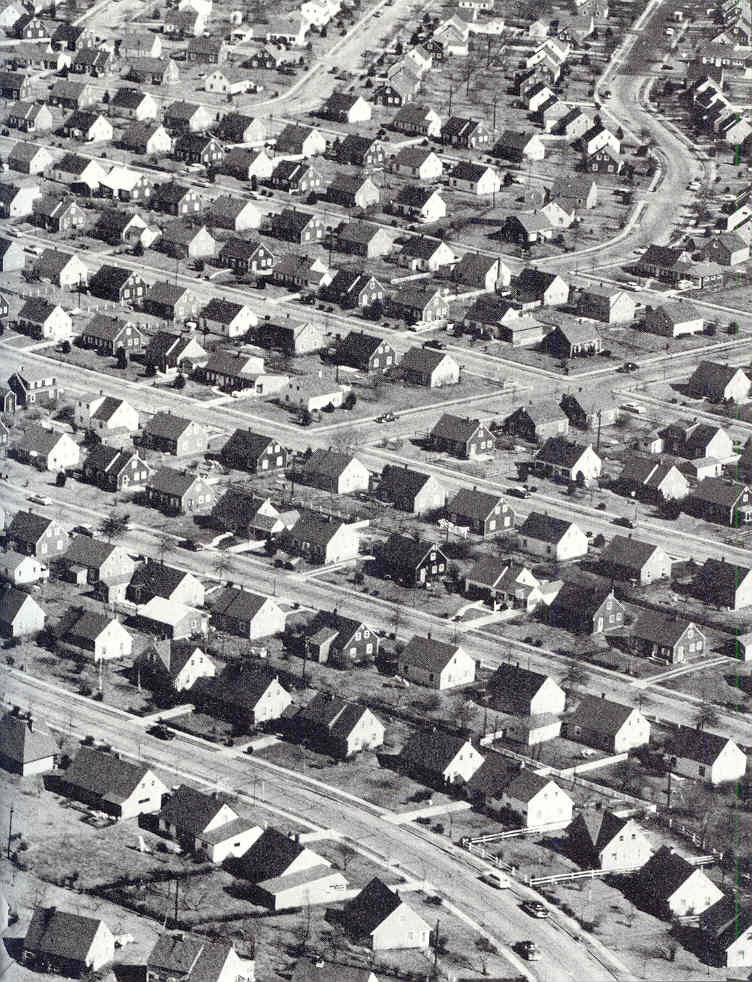
Levittown - Long Island -
home for more than 17,000 families – late 1940s
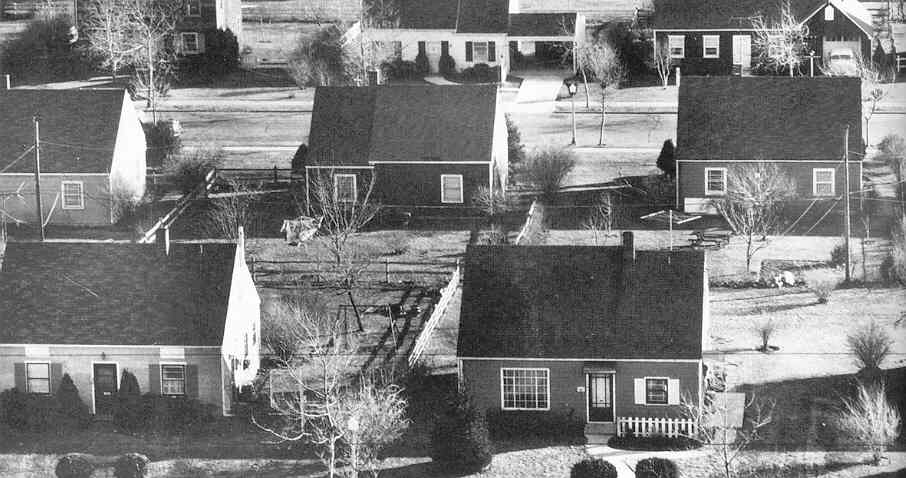
Rapid suburban housing growth
in the post-war years in America. Housing starts jumped from 114,000 in
1944 to 1.7 million in 1950
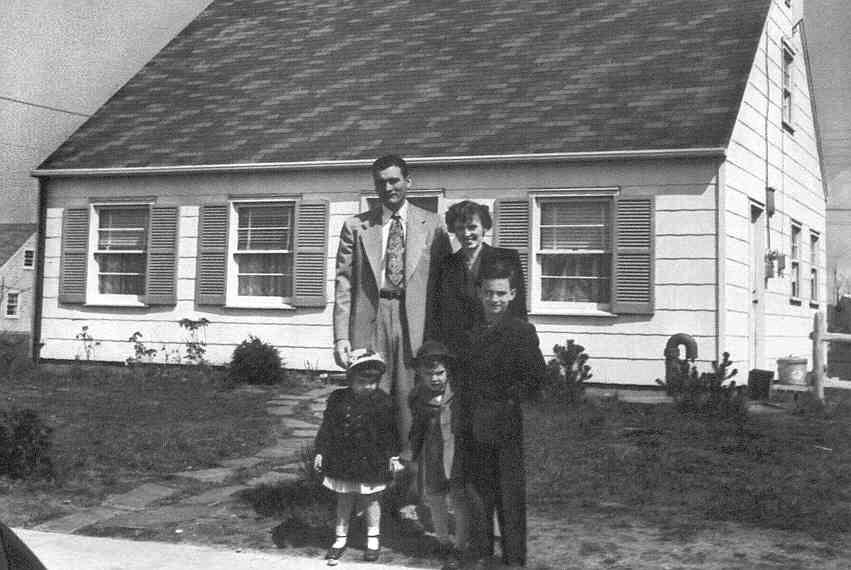 Suburban family in Levittown,
New York.
Suburban family in Levittown,
New York.
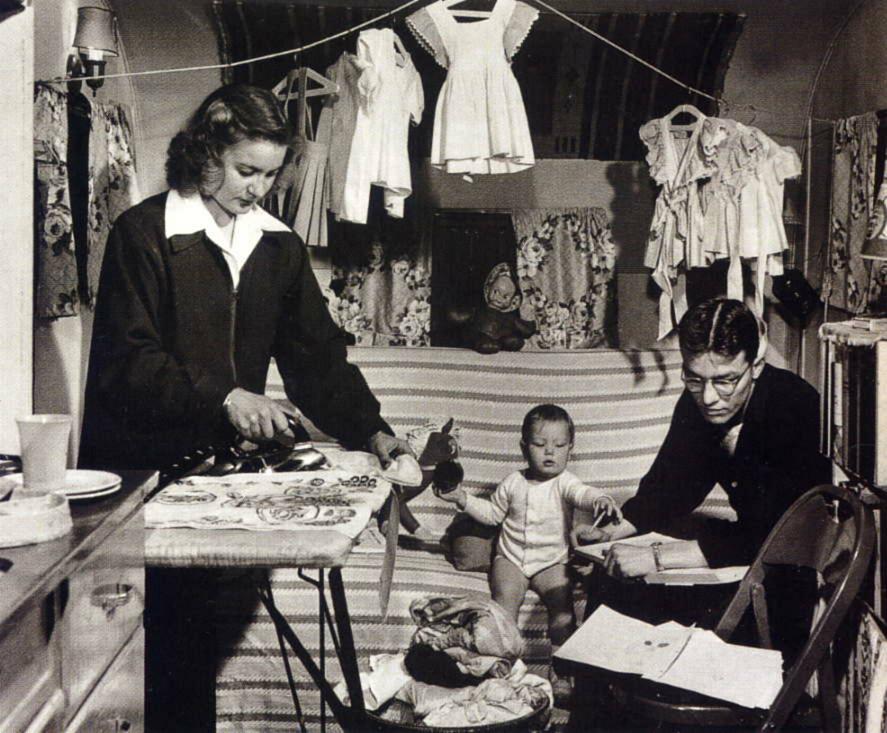
A young American post-war
family living on the GI Bill of Rights – 1947. Charles Smayda's wife irons while he studies
for his courses at the University of Iowa, his bills paid for by Uncle Sam.
In just the first 20 years of the GI Bill of Rights (1944-1964), 10 million former servicemen were able
to attend college and 6.2 million able to buy their own homes.
Britain's
post-war economy was a grand mess. German bombing had destroyed
or deeply damaged Britain's inventory of homes, industrial and
commercial buildings, airports, shipping ports, railroads, roads,
bridges, etc. … in short, the fundamental infrastructure on which
modern life depends. And government funds available to rebuild
that infrastructure were just not there … especially after funding
coming from America's Lend-Lease Program – funds or goods (over $30
billion) that had helped Britain conduct its war effort – was
terminated in 1945.
And with the war over, there would be many young soldiers looking for
civilian employment … at a time when the British economy seemed deeply
stalled. A high level of unemployment – and probably accompanying
labor strife – was a great possibility facing postwar Britain.
According to the economic theories put forward by the economist John
Maynard Keynes – theories that Britain (and most of the West) had been
following since the mid-1930s – this situation indicated that it was
time for the government to step in and take over the task of rebuilding
those infrastructure items … not just public roads and buildings but
even family housing. But where would the funds be coming from
that would finance just such an effort? Raising taxes on an
impoverished citizenry was definitely out of the question.
And even to the extent that the government could finance some
rebuilding … where were the basic materials going to come from?
The industries that provided such basic materials were themselves in
massive disrepair. Even food to feed the working population and
their families was short … strangely shorter than what it had been
during the course of the war itself. Almost every food item was
now in short supply … and thus food rationing would have to be deepened
further in meeting the most basic needs of the British citizenry.
Then there was the matter of Britain's commitments abroad … naturally
expected of what was supposed to be a "great power." The British
government was responsible not only for the care of its own citizens,
it was handed the responsibility of getting the British portion of
occupied Germany up and running. And for Germany it was not
a matter of little food available. It was a matter of no food
available for the Germans under British jurisdiction. Indeed,
British domestic rationing even of bread was necessary in order to feed
a starving German society.
And of course there were the long-standing responsibilities of empire …
something that offered Britain great prestige – but seemingly little
else at a time of enormous shortages. How could the expenses of
managing a huge empire abroad be justified in the face of these
shortages at home? This would be a very big point of political
debate within the British Parliament.
Attlee's Socialist program
Although Attlee was a deeply committed Socialist at heart, as Vice
Chancellor under Churchill, he had toned down much of Socialism's
anti-capitalist rhetoric. Now as Chancellor, he focused on
putting some basic social services in place, ones he had promised his
supporters during the war. Actually in this matter, Churchill had
been himself in general agreement. Thus one of the first things
Attlee got up and running was the extension by way of the National
Insurance Act (1946) of welfare support for the unemployed, for the
sick or disabled, for retirees, and for family child support.
Then he undertook an even greater challenge in bringing the British
health care industry under government management … offering the British
citizens free "cradle to grave" health care (dental and eye care not
covered however). He was able to answer the strong opposition
posed at first by the medical profession by offering doctors the right
to continue to run private practices – while hospitals and major health
centers came under full governmental management (its National Health
Service) in 1948. And the pharmaceutical industry was
brought under governmental regulation in terms of its pricing of drugs,
etc. In this too he had the support not only of his Labour Party
but also Churchill's Conservative Party.
But being a Socialist, it was inevitable that Attlee would also want to
take on capitalism's world of industry and finance … and "nationalize"
it all. Actually, much of that industrial world was not doing
well … especially the coal industry which was at a point of bankruptcy
when it was nationalized in 1946. And the all-important Bank of
England was taken out of the hands of private investors and simply made
into an entirely government-directed operation (also 1946). From
that he moved on to bring Britain's international airlines under
government management as the company, British European Airways (1946),
similarly electrical and gas services under the British Electricity
Authority and the Gas Council (1948), and railroads merged into a
single government-run company, "British Railways" (1948). In
general, these actions received widespread British support.
Where Attlee ran into trouble was his nationalizing of the British iron
and steel industry in 1949 as the British Iron and Steel Corporation of
Great Britain. This industry had been running on its own … and
quite profitably so! Not only industrial owners but also the
Conservative Party opposed this move strongly … although with Labour
holding a strong majority in Parliament there really was very little
that the opposition could do about this move.
The social-cultural picture
In many ways the social picture of Britain in the postwar years was not
all that different from America's. Home, family, community, and
social-religious behavior remained quite traditional and quite central
in importance. And the rigorous requirements of getting through
the recent war – and now the austerity of the postwar period – only
strengthened those social instincts. Even the feminism of the day
was mostly about helping women operate a stronger home. And the
British considered themselves strongly Christian … not only in social
performance but also in personal faith.
But these same instincts will not be passed on to the next generation … also much like the situation in America.
But for the time being, the British will find themselves preoccupied
with the challenge of just getting things back to normal as quickly as
possible. |
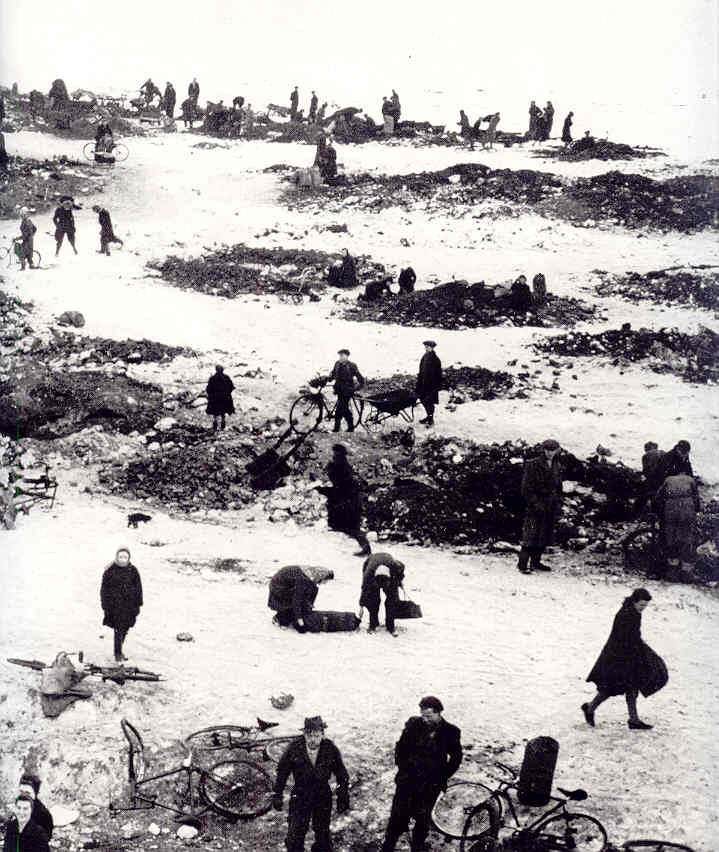 Britishers looking for coal
– Feb. 1947
Britishers looking for coal
– Feb. 1947
Cold, rundown mines and
lack of transport made the fuel shortage worse than during the War
THE NEW FRENCH FOURTH REPUBLIC |
|
The Provisional Government of the Republic of France
With Paris just liberated and the Allied armies moving fairly quickly
against the retreating Germans – and the flight (and capture) of French
officials who had served in the Vichy Government – a new Provisional
Government was set up in September of 1944 … formed basically from the
French Committee of National Liberation headed by De Gaulle (in
partnership with General Henri Giraud), the latter organization set up
in London in June of 1943. It was well understood by all that De
Gaulle would head up the new Provisional Government … assigned the task
of getting France back to normal – and coming up with a new
Constitution.
Bringing the Vichy French to justice
There would have to be the Vichy legacy to deal with … both the
individuals who directed that government and the matter of the legal
standing of the laws enacted under that regime. Even prior to the
setup of the Provisional Government there had been thousands of acts of
local "justice" … when possibly as many as 10,000 collaborators were
killed – although the exact numbers are hard to come by. In any
case, some 300,000 individuals were brought to formal trial in the next
years, with over 6,000 individuals sentenced to death … although only
791 executions were ever actually carried out. Those executions
included Pierre Laval, who served at various times as French prime
minister during the 1930s … and who continued in that same capacity
during the Vichy era. And the heroic-tragic individual Pétain
would be sentenced to death – but have his sentence commuted by De
Gaulle to life imprisonment.
The Provisional Government attempted to secure a line of legal
legitimacy connected to France's Republican past (the former Third
Republic) … but found passing that line through the Vichy era to be
very tricky. It finally dismissed the whole matter by simply
declaring all acts issued by the Vichy government to be illegitimate
and thus null and void – despite the Vichy government having actually
been authorized legally by a popular referendum in 1940. Was
therefore France as a nation guilty or not for what had transpired
during the Vichy years? The answer was to be "not guilty."
Constituting a new Fourth Republic
Elections were held in October of 1945 to either restore the old Third
Republic – or form a new constituent assembly to design a new, Fourth
Republic. The results were that 96% of the voters were in favor
of forming a new constitution. In the same vote the French
Communist Party, headed by Maurice Thorez, secured 26% of the vote and
thus the same percentage of seats in a new constituent assembly.
The Socialist SFIO (French Section of the Worker's International),
headed by Guy Mollet, gained nearly 24% of the vote. And the
Centrist/Catholic MRP (Popular Republican Movement), headed by Robert
Schuman, gained nearly 25% of the vote. These three parties then
decided simply to work together as a governing coalition. Now the
country could get to the task of designing a new French Republic.
It became quickly apparent that the coalition partners wanted to see
basically a continuation of the structure of the Third Republic … run
by a very "democratic" National Assembly, one that represented exactly
the variation and spread of France's numerous political groupings.
This was exactly what De Gaulle did not want to see happen. He
was hoping to see a government directed by a strong presidential figure
(with guess who as that president!) … not by an assembly made up of a
confusing array of various parties, small groups constantly coalescing
and then breaking up over every matter that the French government was
assigned to deal with. French governments of the Third Republic
seemed to last only months – not years - making for political
instability and weakness. De Gaulle pointed out that this was the
very same arrangement that had crippled the French Third Republic when
faced with the growing dangers in the 1930s of both Stalin's Communism
and Hitler's Fascism. But he got nowhere with those elected to
decide this matter. To most of the French, democracy and
parliamentary government were totally synonymous. Indeed, he was
even accused of being a latter-day Bonapartist … seeking like the
former Napoleons to want to direct the nation personally. Being
thus spurned, he withdrew from French leadership in January of 1946.
Then the first draft of a new constitution, put before the French
voters in May, found itself actively opposed by the Gaullists – but
also by the centrist MRP and by conservative voters – because it
provided for only a single legislative body … dismissing a Senate as a
second and possibly counterbalancing parliamentary body. In any
case, the voters turned down the new constitutional proposal.
Consequently, a second round of elections for another constituent
assembly was held the next month. This election however
strengthened the Catholic and centrist MRP somewhat, also (but only
slightly) the Communists, but weakened the Socialist SFIO a bit.
And it restored the role of a second chamber or Senate in the new
Republic. But it still made the President simply a symbolic
figure – as he had been in France's Third Republic – with France's
executive power held in the hands of a prime minister … someone
supported in power (usually briefly) by an ever-changing array of
political coalitions. But this time, when the proposal was put
before the French that October, it was approved - despite De Gaulle's
active opposition. But it was approved only by 53% of the voters,
with 31% actually failing to vote at all. Not a good start.
De Gaulle would go on to create his own political party, the Rally of
the French People (RPF) in April of 1947 … hoping yet to get some kind
of revision of the constitution more in line with his own
thinking. The RPF did fairly well, particularly in the local
municipal elections. But it would never acquire the dominating
vote needed by De Gaulle to do the constitutional work he was hoping to
see. The MRP seemed unable to hang onto the centrist/conservative
support that De Gaulle was hoping would swing behind his RPF.
Getting France back up and running again
Like Britain, France had been hit hard by the war … especially as the
battles raged across the land after the Normandy landing in June of
1944. Much of the country's infrastructure, factories and housing
was laid waste.
Getting the French economy back in proper order was going to be very
expensive … at a time that France's wealth was deeply depleted.
Its overall national income in 1945 was estimated to be only half of
what it was in 1929 … just prior to the beginning of the Great
Depression.
America's Lend-Lease assistance ended in mid-1945 and a
Republican-controlled Congress was not interested in sending more money
abroad (at least at this point). That was a shock to the French
economy. However, America did rather immediately extend to France
some $2 billion in loans, which certainly helped.
The French government – like most of Europe's governments – tended to
see an economic comeback in the government's nationalization of the
country's various industries … in order to put them under a larger
developmental program and not just under individualistic
entrepreneurial development, as America tended to go at things.
We have seen how this was the case in Attlee's Britain … although
actually the French had started down this path even before the start of
World War Two … with the nationalizing in 1937 of France's unprofitable
railroad industry. Elements of the armaments and aeronautics
industries were also nationalized during that same period.
In any case, the need for planned redevelopment seemed so natural to
the French that the program of nationalization put in place after the
war by Jean Monnet, head of the French Planning Commission, met
generally with French approval. Thus the gas and electricity
sectors were nationalized in 1946 … with the nationalizing of the
country's coal and steel industries – as well as its banking and
insurance industries – following soon thereafter. However other
industries – car, oil, and pharmaceuticals, for instance – were judged
to be able to restore themselves … and thus were left out of the
nationalization program.
But – as elsewhere in Europe – France was hit hard by a fall in its
economy in 1947 … a huge drought and consequently the worst harvest in
150 years – and massive inflation due to rapidly rising demand greatly
exceeding available supply. Not surprisingly, France would be hit
(much like the rest of Western Europe) by workers' discontent …
reaching riotous levels by late April of 1947.
This in turn potentially played well into Communist hands. But
this quite visible possibility of Communism's expansion across Western
Europe also stirred America to take a strong counteraction: the
Marshall Plan (1948). Just under $3 billion was eventually
extended by America to France as purely a gift – but accompanied by
expectations of a carefully planned use of the gift … not really a
problem for the French, who were already heading down that path!
This Marshall Plan aid helped France enormously to get its economy back
up and running … and defuse the worker unrest – the primary reason for
the aid in the first place! |
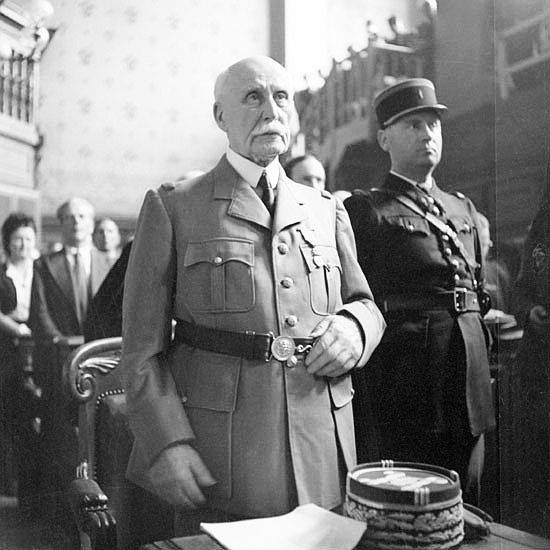
Pétain on trial – July-August 1945
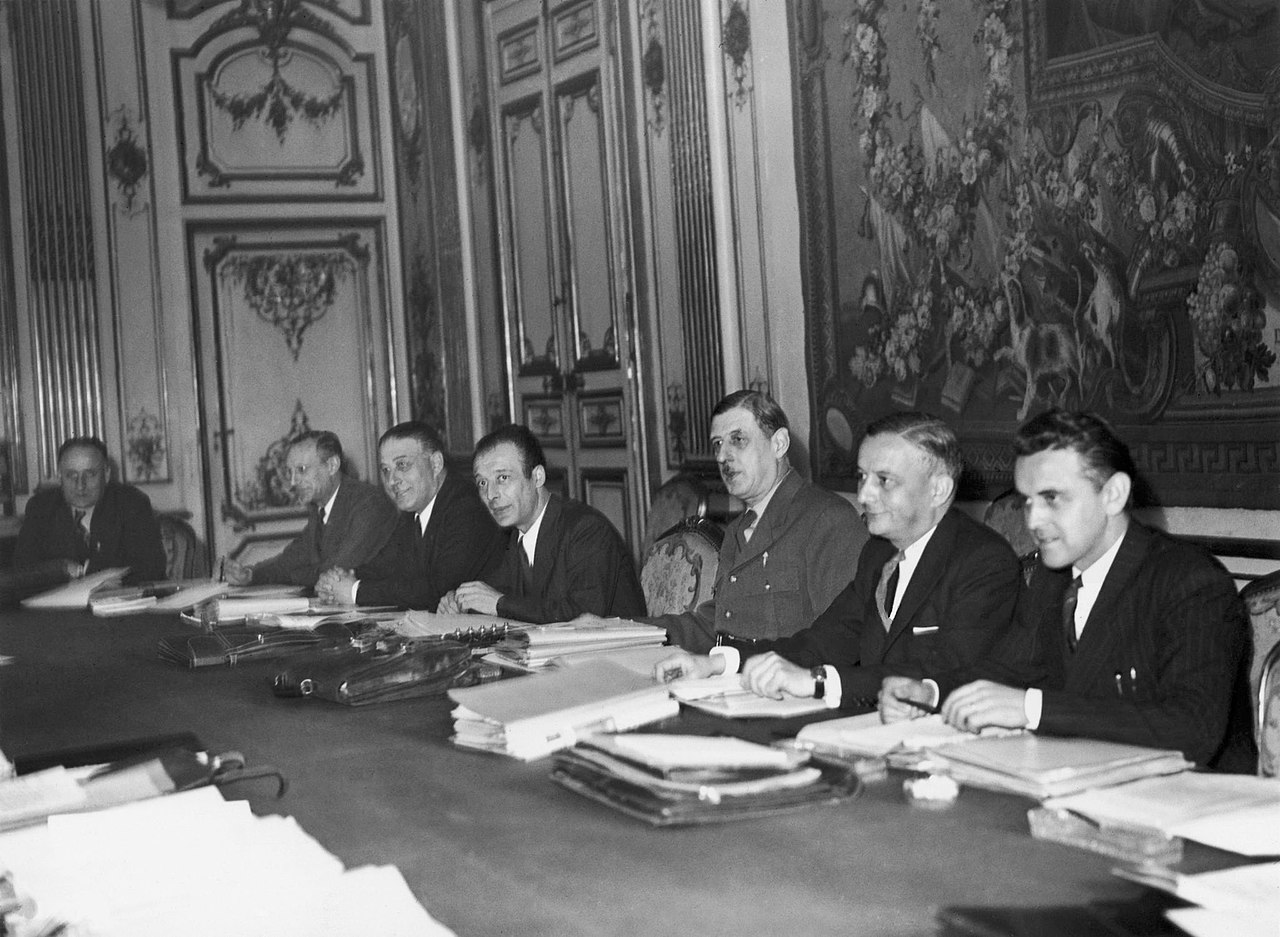
General Charles De Gaulle and his postwar Provisional Government of the French Republic – November 1945
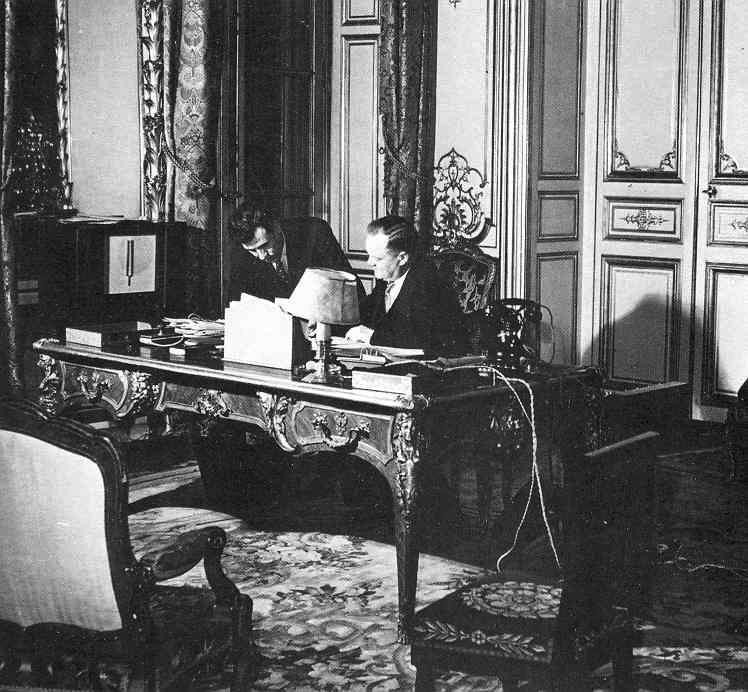 French Communist leader Maurice
Thorez (right), Vice Premier in post-war France – Dec. 1946
French Communist leader Maurice
Thorez (right), Vice Premier in post-war France – Dec. 1946
|
A republic instead of a monarchy
Much like France having to deal with the legacy of the Vichy
government, Italy had to deal with the legacy of its King Victor
Emmanuel III having been a close ally of Mussolini since 1922 when the
king asked Mussolini and his Fascists to take charge of Italy's
government. That alliance, having continued during the early days
of the war, only made the king an Italian traitor in the eyes of many
Italians.
However, with the Allied invasion of Italy in 1943, the king forced
Mussolini to step down from his position … and then signed an armistice
with the Allies. The Germans were not happy about this … and
struck back at the post-Mussolini Italian government, forcing the king
and his government to have to flee south to Allied lines … and allowing
the Germans to set up a puppet state in German-held northern Italy
under Mussolini – once they had rescued him from prison.
But the king found himself frequently in disagreement with the Allied
commanders. Thus in June of 1944 he turned most of his
activities over to his son Umberto. … and distanced himself from all
the political dynamics of the day.
The very depth of the wartime destruction of Italy however only
heightened the bitterness of many Italians toward their government …
and the king, hoping to save the monarchy, formally abdicated his
throne to Umberto (May 1946) … at the same time promising to call for a
national referendum on this matter of monarchy versus republic.
But the referendum, held only a month later, went 54% in favor of a
republic. Both he and his son then went into exile.
But it was a very close election, with some questions about the results
… and indicating a sharp division in Italy on the matter, the
industrial North highly supportive of a republic and the rural South
highly supportive of the monarchy. But the decision in favor of a
republic would stand nonetheless.
What shaped up next followed lines very similar to France's …
representation to the Constituent Assembly being made up heavily of
Communists (19%), Socialists (21%), Christian Democrats (37%) … and an
array of a number of smaller conservative parties.
The shape of the final constitution was also similar to France's:
a bicameral legislature or Parliament of a Chamber of Deputies and a
Senate, with the government actually in the hands of a prime minister
and his ministerial council (or cabinet). The president (elected
by the legislature) would hold mostly just ceremonial powers.
Cleansing Italy of the Fascist legacy
Needless to say there would be serious reprisals taken against those
who had supported the Fascist regime. But this would be a very
complicated matter because Fascist membership had been an absolute
requirement of anyone wanting to hold a job in the major
professions. And the Italian resistance had not been that fair in
its handling of its opponents either. Many of them had to be
arrested as well.
Nonetheless, some 15,000 individuals were purged, even killed … and
like the French, any woman having relations with a German during the
war years (often necessary to secure food for a girl's family) was
humiliated by having her hair shaved off and being displayed in the
streets as a traitor-prostitute.
But the new regime, under Christian Democrat leader Alcide De Gasperi,3
opposed this dynamic … and the Communist minister of justice Palmiro
Togliatti was given the lead in this matter. And things then
settled down in Italy … pleasing the occupying Allied authorities
greatly.
Trying to get Italy back to normal
And like France, economic conditions in Italy were horrible because of
all the fighting that took place on Italian soil. Then too there
was some "punishment" delivered to Italy for its pro-Fascist role in
the war … Italy losing territory as payoff to its neighbors,
particularly the Yugoslavs. The award of sections of northeast
Italy to Yugoslavia produced the emigration of 200,000 to 300,000
Italians from the areas awarded to Yugoslavia … worsening the economic
picture for an Italy that was already having trouble feeding its
population. And it lost all of its colonial holdings.
And like France, Italy would go through intense labor strife in the
May-June general strike of 1947. But then (beginning also in 1948) it
would receive Marshall Plan aid totaling $1.2 billion … helping Italy
move into a period of phenomenal economic growth (beginning around 1950
and continuing another 20 years).
3But
unlike France, Italy would get the continuing service of its prime
minister De Gasperi from 1945 all the way to 1953 … stabilizing Italian
politics greatly.
Italy, despite its dropping out of the war earlier, still finds life very hard
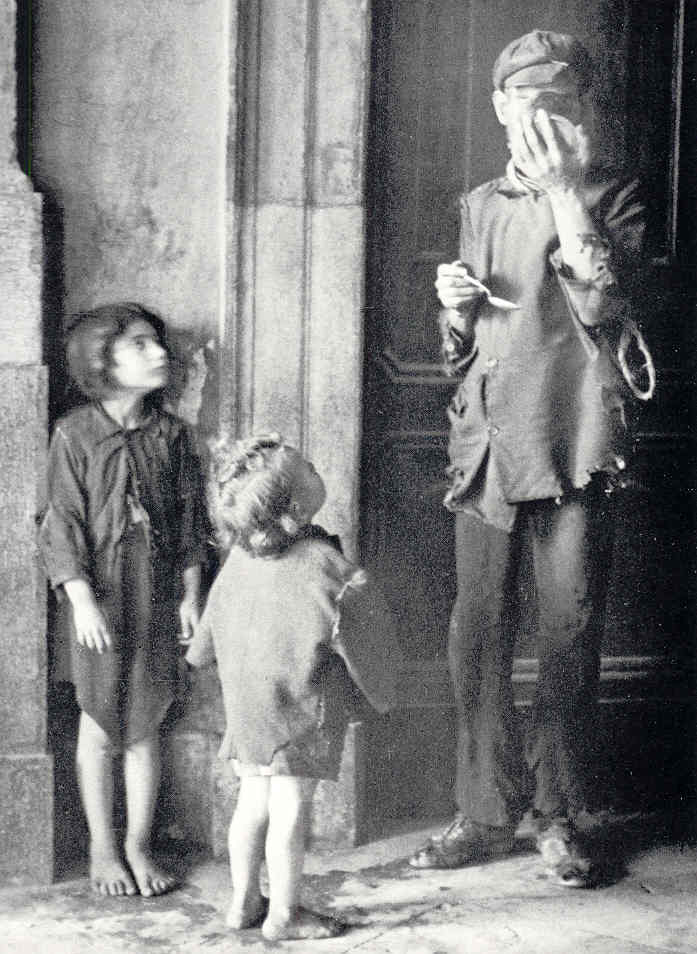 Hunger in Palermo,
Sicily
Hunger in Palermo,
Sicily
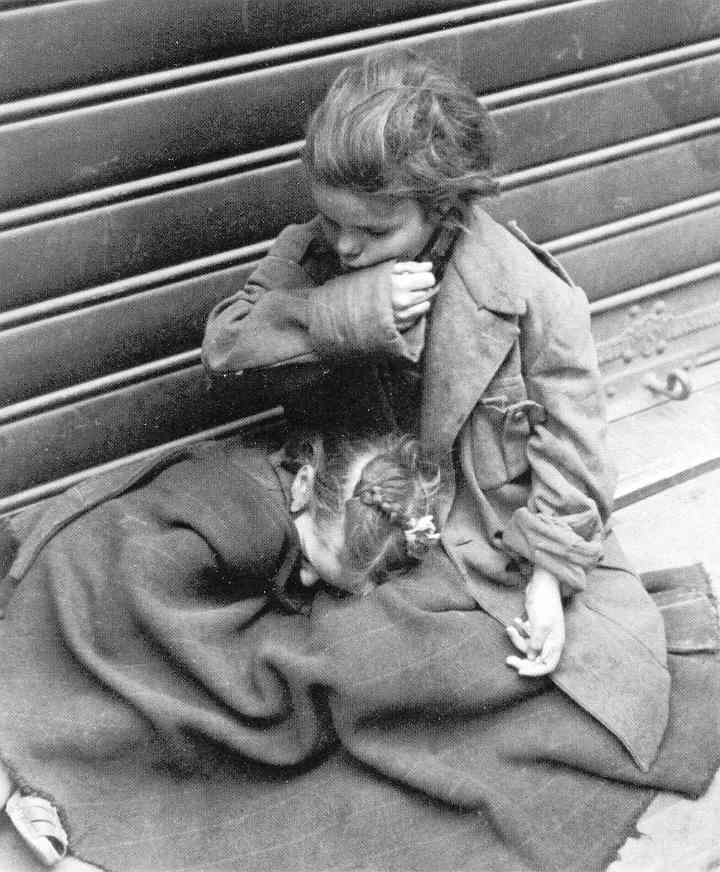 Homeless orphaned sisters
on a street in Rome
Homeless orphaned sisters
on a street in Rome
Toni Frissell - courtesy
of Frissell Collection, Library of Congress
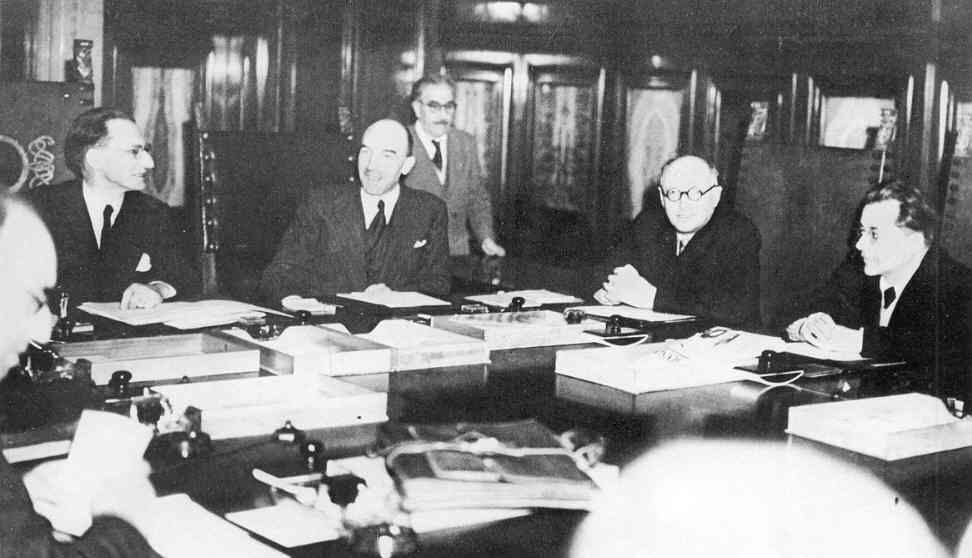
Italy's postwar political
coalition – and rivals: Christian Democrat Alcide de Gasperi (rear
left), Socialists Pietro Nenni
(third from left) and Communist Palmiro Togliatti (right) – Rome December
1945
SOME OF THE OTHER COUNTRIES IN THE NEW EUROPEAN "WEST" |
|
The Netherlands
During the war, the Dutch had been as active as possible against the
Japanese, at least in the early stages of the war. But they could
neither replace their naval losses in battleships (although their
submarines survived and continued to serve) nor resupply their troops
in Indonesia … and lost out to the Japanese, who overran their
Indonesian Empire. The results of this would be horrible to the
Dutch, both military and civilian, who were carried off to horrible
work camps … and to the local Javanese, who were forced in the millions
to work under the most horrible conditions for the Japanese (many women
forced into prostitution as well). Thus the high death rate in
the Dutch East Indies.
As for the situation in Europe, the Dutch had been hoping for either
large reparations payments or the acquisition of German territory –
reaching possibly as far as Germany's industrial Rhineland – in
compensation for the destruction of both human life and social
infrastructure.4 But with American rejection of the plan,
that idea was quickly dropped.
The Dutch, like the French, had large numbers of both
collaborators and members of the underground resistance … making it
difficult at war's end to be sure of which role an individual might
have actually played, because the resistance had to appear as
collaborators in order to get vital information from – or even just
survive – their German occupiers.
Thankfully the Dutch royal family and parliamentary government had
chosen to escape to Great Britain in May of 1940 … and serve the Allied
effort from there for the duration of the war. After the war, the
royal family returned to the Netherlands to resume their former roles
and a ministry was formed from among the London Dutch … making the
postwar political situation in the Netherlands much less troubled than
elsewhere.
But still, economic conditions in the country were terrible … with
little food available. The harsh winter of 1944-1945 … and German
reprisals against the Dutch helping the Allies liberating their land
(food and supplies cut off in the lands still under German occupation)
did not help matters any. And thus some 50,000 Dutch civilians
died of starvation or cold and disease that winter.
Even with the end of the war, deep rationing was required … and the
Dutch were encouraged to emigrate – some half million going mostly to
Canada, Australia and New Zealand.
The Catholic People's Party directed the government (1946-1948) in
coalition with the Socialist Labor Party … undertaking the challenge of
getting the Dutch economy back up and running – and the Dutch East
Indies back under Dutch control5 … both of them almost impossible tasks.
Belgium
Belgium had laid across Germany's path in its effort to conquer France
… and Belgium had paid a huge price. Likewise, Belgium lay across
the Allied path on its way to the conquest of Nazi Germany … and again
paid a huge price for that.
Belgium also suffered from the fact that many Belgians collaborated
with their Nazi occupiers, whereas others were very active in Belgium's
resistance movement. Tragically, this collaboration/resistance
dualism tended somewhat (though not exactly) to follow Belgium's ethnic
dualism – long-dividing the country along north (Dutch-speaking
Flanders) and south (French-speaking Wallonia) lines.
But the Germans had been very oppressive to both groups … taxing the
Belgians for German war operations to a point that very little was left
for Belgium's maintenance itself. Also some 375,000 Belgians
worked in German factories … half that number having signed up for such
work and half being conscripted after the 1941 conscription order.
Of course Allied bombs made no distinction as to German workers and
conscripted foreign workers … and many Belgians died as a result.
Also Allied bombing of strategic sites in Belgium created unintended
civilian casualties (as it did also in France and the Netherlands).
Thus, coming out of the war, Belgium had some major issues to
face. Not only did the country have to deal with the problems of
hunger, homelessness and unemployment, it again had to deal with those
cultural/linguistic sensitivities dividing the north and south of
Belgium … made worse by the question as to what to do about Belgian
King Leopold III.
Leopold had defied his government's demands to take his government to
London, but instead remained in Belgium to continue to lead his
military. Ultimately, there was no way he and his army could hold
off the Germans and he and his army were forced to surrender. At
that point his government fled to London … and Leopold came under house
arrest at his royal palace.
To many Belgians (and others, including Churchill), Leopold's behavior
seemed to be a cowardly – as well as unconstitutional – act (defying
the will of his government). This was especially so when compared
to the continuing anti-German inspiration offered by the Dutch royal
family from their position in London.
However, Leopold actually used whatever influence he still commanded to
get Hitler to back off from his plans to deport a half-million women
and children to work in German munitions factories. He also
visited Hitler to plead for the freeing of Belgian prisoners of war.
After the war there was a huge dispute within Belgium as to whether or
not to continue with Leopold as king. Leopold and his young
family went into exile in Switzerland … while the debate over his
rightful status continued. Clearly, the Flemings wanted him back,
and the Walloons wanted him gone. Finally the matter was
submitted to a national referendum in 1950, Leopold then narrowly being
confirmed in his role by a 57% favorable vote. But that vote was
divided, 70% of the Flemings in favor and only 42% of the Walloons
willing to see him resume his royal role.
On returning to Belgium in July of 1950, he was met by a huge general
strike, with three people killed and the country looking as if it were
moving to some kind of civil war. Thus in August – to spare the
country from further turmoil – Leopold announced his decision to step
down and have his son Baudouin replace him the coming July
(1951). Belgium could now move on to other matters.
Denmark
Denmark, recognizing its own vulnerability (no land barriers between
itself and Germany) had agreed to Hitler's offer of a non-aggression
pact in 1939 … and then tried to remain as neutral as possible when war
finally broke out. Thus Danish resistance was slight when the
Germans took possession of the country in order to open a German path
to a resistant Norway.
At this point, the British – deeply concerned about the status of the
North Atlantic – took control of the Danish colony of Iceland (1940) …
ultimately sparking the decision of Iceland to declare its independence
in 1944.
At first, Hitler allowed King Christian X and the Danish parliament
(its Folketing) to continue in power … at least partially so – as the
Danish Communist Party was expelled when Hitler opened his war with
Russia in 1941. And the Danish police mostly remained a national
force … although some 2,000 police who resisted Nazi oversight were
sent off to concentration camps.
By 1943, the Danish government was tired of the game … and simply
resigned, with the Germans then taking over the Danish government
themselves.
At about this same time Denmark was able secretly to send most of its
7,800 Jews to safety in Sweden … where neutrality in the war was
seriously upheld.
Ultimately, Denmark was spared the destruction that hit so much of
Europe … and found the postwar period to be more or less a continuation
of things. But therefore Denmark appeared to be a hopeful place
of refuge for thousands of German DPs who flooded Denmark at the war's
end. But a huge death rate accompanied those who arrived very
weak and sick – over 13,000 dying … of whom more than a half were
children under five.
Sweden
Sweden remained "neutral" during the war … preserving that neutrality
from Hitlerian ambitions by selling precious iron ore to German steel
plants during the war. That was a matter of great importance to
Germany.
Sweden did help save its image after the war by its help in receiving
Jewish refugees from Denmark and Norway during the war … although the
numbers involved were relatively small in comparison to the larger
count of European Jews finding themselves in deep danger.
Unfortunately also for its standing, officially it offered rather small
support to its neighboring Finland (actually once a part of Sweden
itself) in the Finns' attempt to ward off the attack by Soviet Russians
in 1939. Sweden did send military supplies to the Finns …
and some 8,000 Swedes took it upon themselves to join the fight on the
Finnish side. And then it did take in some 70,000 Finnish
children attempting to escape Soviet control during the war years.
Towards the end of the war, its "neutrality" began to swing to the
Allied side in the way it allowed Norwegians to receive military
training in its country and how it allowed American planes to use
Swedish air bases to attack German positions in Norway (early-1944 and
after).
Norway
Norway was another matter … because the Norwegians tried very, very
hard to hold back the assaulting Germans. And even when the
Germans were able to position themselves at strategic points in and
around Norway, the Norwegians continued to conduct underground warfare
against their occupiers. It was savage at times.
Worse, Norway was theoretically controlled by a collaborationist
government, headed by Vidkun Quisling, a government that the Norwegians
would come to hate deeply. Quisling and his "Quislings" (now a
term of contempt for such traitors) cooperated actively with the
Fascists … including sending Norwegian Jews to German death camps.
There existed also a Norwegian government-in-exile (Socialist or
Laborite), plus the royal family of King Haakon VII, all located in
London. Thus those hostile to the Quisling regime had something
to rally around.
At war's end Quisling and the "Quislings" would be tried and sentenced ... many to death (such as Quisling himself).
And the Socialist character of the returned government naturally
inclined it towards a social program of government ownership of
Norway's vast natural resources … plus a commitment to cradle-to-grave
governmental care … making Norway a leader in this kind of social
policy.
Spain
Spain stayed neutral during World War Two … and Hitler was willing to
keep things that way for the duration of the war – especially as
Spanish dictator Francisco Franco diplomatically had strong pro-Hitler
sentiments. The Nazis and Mussolini's Fascists had, after
all, helped Franco's own rise to power.
But Franco was no fool, and made it clear that Spain would not allow
any expansion of Hitler's Reich into Spanish territory. Franco
also knew that any actual move in support of Germany would bring
British reprisals … especially coming from British-held Gibraltar –
Gibraltar considered a matter of absolute necessity to the British
Empire. Spain was just recovering from its violent civil war
(1936-1939), and Franco knew that Spain was thus in no position to take
on the British. Also, the threat of the withholding of American
oil sales if Franco betrayed his "neutrality" was a sobering matter to
Franco.
He did however help the Germans to the extent that he sent a full
division of his troops to help Germany fight Soviet Russia when
fighting broke out between those two powers in 1941. But he made
it clear that they were to be used only to fight Communist Russia … and
nobody else.
But as the war advanced – particularly after the Germans and Italians
were defeated in North Africa in mid-1942 – Franco began to shift his
"neutrality" to the Allied side … at least to the extent of ending
further aid to Germany's cause.
But he ultimately paid a price for his "neutrality" … at first not
being allowed to join the pro-Allied United Nations. Indeed,
Spain underwent diplomatic isolation … at least until the mid-1950s,
when the Cold War was running quite strongly and Franco's
anti-Communism appeared more appealing to an anti-Communist West.
4For
instance, the Germans had literally leveled Rotterdam to the ground in
their attack on the city in May of 1940 … and had required some
half million men to work as forced-labor in German factories.
Also the Germans had wiped out whole villages in reprisal against
actions undertaken by the Dutch Resistance.
5With
the surrender of the Japanese government in August of 1945, the
Japanese military authorities in the Dutch East Indies helped to
organize an anti-Dutch Javanese independence movement led by Sukarno …
as simply a piece of final reprisal against their European
enemies.
Attempts to build a post-war peace
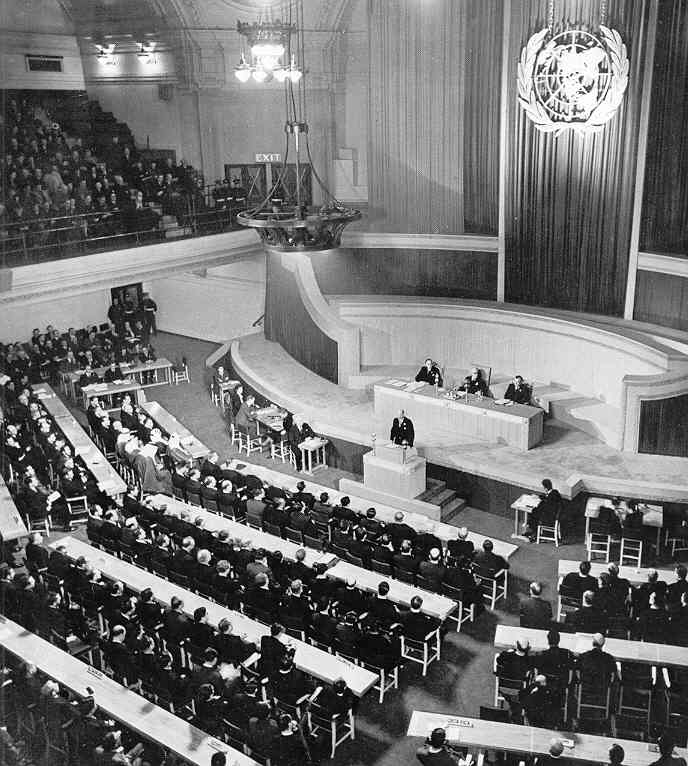 The General Assembly of the
United Nations meets in London - 1946
The General Assembly of the
United Nations meets in London - 1946
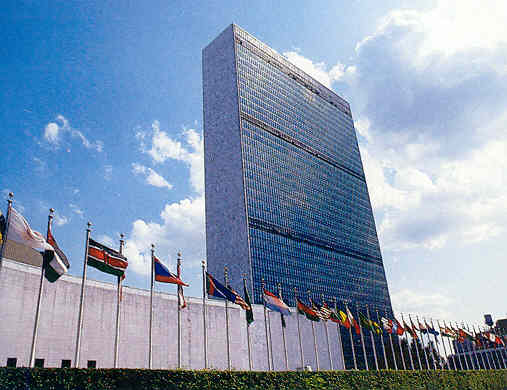 United Nations Headquarters
- New York City
United Nations Headquarters
- New York City
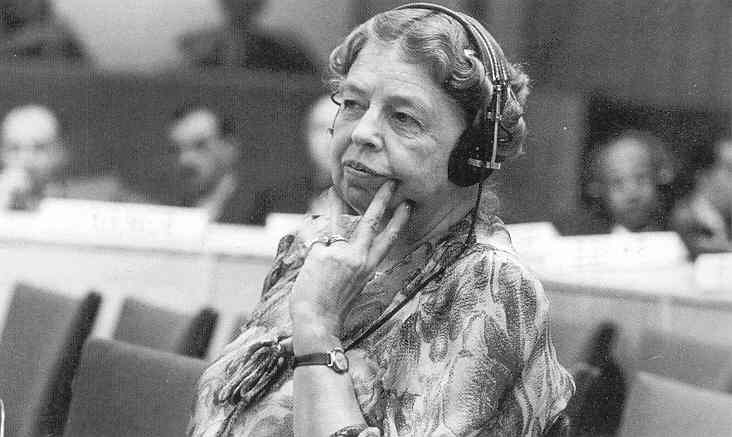 Eleanor Roosevelt – Truman's
representative at the United Nations
Eleanor Roosevelt – Truman's
representative at the United Nations
United Nations

Go on to the next section: The Stalinization of East Europe
 Miles
H. Hodges Miles
H. Hodges
| | | |


 The dividing and occupying of Germany
The dividing and occupying of Germany
 The Nuremberg War Crime Trials
The Nuremberg War Crime Trials
 Some of the other countries in the new
Some of the other countries in the new




















 Britishers looking for coal
– Feb. 1947
Britishers looking for coal
– Feb. 1947




















































